The Scientific Notebooks of Thomas Townsend Brown
Volume IV


 Qualight Systems is deeply grateful to Rex
Research in Jean, Nevada for taking on the task of
adapting Brown's Laboratory Journals Nos. 1, 2, and 4 to the internet.
Copyrighted © by The Townsend Brown family. All rights reserved.
Qualight Systems is deeply grateful to Rex
Research in Jean, Nevada for taking on the task of
adapting Brown's Laboratory Journals Nos. 1, 2, and 4 to the internet.
Copyrighted © by The Townsend Brown family. All rights reserved.
 Contents
Contents
 Page 1
179. Two Glitches of Extraordinary Magnitude.
Page 1
179. Two Glitches of Extraordinary Magnitude.
Honolulu, HI; Jan. 28, 1975.
During my absence from the Haleakala Observatory (trip to the mainland Dec. 17 ’74 to Jan. 16 ’75) the automatic computer was continued in operation.
Readouts showed a sudden and intense disturbance on all sensors beginning at (or shortly after 1 AM Honolulu 150 Degrees time on Dec 21, 1974, and
lasting approx 3 hours. On certain sensors the effect lasted several days.
Another disturbance, also sudden and intense, occurred beginning at, or shortly after, 7 AM Honolulu time, on Jan. 7, 1975. This disturbance, on
certain sensors, also lasted several days.
 Page 2
180. Basic Circuits for Patent Application.
Page 2
180. Basic Circuits for Patent Application.
Honolulu, HI; Jan. 28, 1975.
One cannot patent a rock, even if the rock generates electricity! But one can patent a circuit using a resistor, a method patent, if the results
represent a new and useful application.
Hence, it is appropriate at this point to illustrate a series of basic circuits which might form the fundamentals leading to patent protection.

 Page 3
Page 3

In certain special cases where the resistive materials, like granitic rocks, are electrically polarized, the diode rectifiers need not be used, but
their use does not detract in such cases.
Even with granitic rocks, which basically act as gravito-electric receptors, and are slightly polarized naturally, the use of the diode improves
performance as an electrical energy source. The method therefore includes the 3 circuit elements, resistor, diode and (storage) capacitor.
 Page 4
Page 4
In describing the operation of this form of electric generator, it's believed that the resistor (any high resistance) intercepts radiation from the
ambient (possibly gravitational radiation from space) and then coverts the incoming energy to RF (broad noise spectrum) intrinsically within the body of
the resistive material. This RF noise appears at the terminals of the resistor or at the sides of the granite block (for example) to which electrodes have
been attached.
This RF is then rectified by the diode and the DC is stored in the capacitor. The terminals of the storage capacitor provide the output leads of
the "generator".
As mentioned earlier in these notes, certain granitic rocks appear to be electrically polarized and put out DC without the aid of an external diode.
The rectifying action obviously takes place within the body of the rock. It is not conceivable that the DC output could in any way originate externally if
one assume the source is gravitational (or other) high frequency radiation. No external DC source, such as atmospheric electric fields, appears to be
operative.
A suggested method claim may be:
(1) Method for generating electricity, consisting in utilizing a circuit containing a resistor, diode and capacitor, connecting the same in series, and
exposing said circuit to an ambient energy source.
 Page 5
Page 5
(2) An electric generator comprising a circuit containing a high resistance, a diode rectifier and a storage capacitor whereby an electrical
potential difference is created and stored for use.
(3) A generator according to claim 2 utilizing a body of resistive materials as the high resistance.
(4) A generator according to claim 2 utilizing granitic material as the high resistance.
(5) A generator according to claim 2 wherein the diode rectifier is an integral part of the polarized resistive material.
(6) A generator according to claim 2 wherein polarizable resistive material possesses capacitance.
See also Sec. 140 in Notebook No. 3, dated 1-23-74.
T. Townsend Brown (1-28-75)
 Page 6
181. Possibility of Augmenting Voltage Output by Passing Current through Resistors.
Page 6
181. Possibility of Augmenting Voltage Output by Passing Current through Resistors.
Honolulu, HI; 1-29-75.
In the foregoing section, the only current which passed thru the resistors was that which was self-polarized. Aside from the RF current itself, the only
other current was DC from the diode action.
The thought occurs that if this phenomenon is rooted in resistor noise (from whatever source), it may be increased by increasing the (bias) current
thru the resistor.
Hence, the following circuit should be considered:

 Page 7
182. The Effects of High Temperature.
Page 7
182. The Effects of High Temperature.
Honolulu; 2-2-75.
All the sensors seem to have temperature effects, some rather unpredictable. This is the reason we have preferred to place the sensors in a
temperature-controlled cabinet. Under constant temperature, the observed variation in voltage output were believed more clearly to reflect the
variations in the ambient radiation, whether gravitational or otherwise.
In general, it appears to e noted that voltage output increases with temperature. If this were the result of thermal noise, the additional output
may be directly traced to the incident (incoming) thermal energy.
If, however, the increase in temperature produces an increased susceptance to the incoming gravitational radiation, then higher temperature brings about
increased gravito-electric conversion efficiency, and higher readings are the result.
No critical tests of this possibility have been made. The thought is being presented here merely in regard to increasing sensor (converter) output or
efficiency.
Going further along this line, it is proposed that high temperature rock tests are in order. How high to go is a matter of speculation. Do red hot
rocks produced high output voltages?
 Page 8
Page 8
The answer is important in connection with "in-hole" generation of electricity from dry-rock geothermal reservoirs.
To date, all extraction of energy from geothermal sources comes about thru the emission and harnessing of steam or hot water. No method seems to be
available for the direct conversion of in-hole heat to electricity. Ordinary thermoelectric generators require both hot and cold junctions. To my present
knowledge, there is no (single) hot junction thermoelectric converter available. It is thought here that red hot rocks may do this kiNd of job.
Hence, could it be that hot rocks (with suitable electrodes attached) may generate RF which could be conducted away (by coaxial cable) and subsequently
rectified? Not only would such a system completely revolutionize the concept of obtaining geothermal energy but it would have many other applications as
well.
Commercial generating stations today use fuel (coal, gas, oil, etc.) to generate steam which then runs turbines and electric generators. Converting
heat directly into electricity would eliminate the steam step and conceivably increase efficiency substantially.
 Page 9
Page 9
Systems would be as follows:

 Page 10
183. Re-Emission of Radiant Energy by Masses.
Page 10
183. Re-Emission of Radiant Energy by Masses.
Honolulu, Feb. 7, 1975.
In Sec 173 of Notebook #2, I discussed the possibility that various regions of the Earth’s surface may be radiating energy. This radiation may be
gravitational or it may be something else not yet identified or recognized.
This hypothesis has grown out of the strange behavior of the rock sensors in various location, or when moved from place to place.
When one considers that a single rock generates an emf which is conducted away, it means that energy is being removed from the rock. If the rock is to
remain stable as to its energy content, it must receive energy at the same rate it is losing energy. Hence, there must be incoming radiation. This, I
believe, is basic.
Now, if the electrical current is opened, so that no electrical energy is conducted away from the rock, then the internal energy of the rock builds up
to a saturation point. Either it must at this point, refuse or reject any further incoming energy or it must re-emit that energy as fast as it is
received. Since there appears to be no mechanism to valve the incoming radiation I am inclined to the latter view that re-emission takes place, but
this re-emission need not be (and probably is not) within the same spectral band as the incoming radiation.
 Page 11
Page 11
In this respect, the action is similar to fluorescence, were light is re-emitted, but at a different frequency.
There are other examples. RF radiation striking matter causes an increase in temperature so that as the temperature rises, infrared is emitted and this
increases until a balance --- input vs output --- is reached. All phosphors, in general, do the same thing.

Assuming a constant primary, then
E
pri = E
sec + E
elec
If the electrical circuit is opened then
E
pri = E
sec
Now, it follows necessarily that all rocks must re-emit or re-radiate, especially if there is no conversion to electricity.
If there is conversion to electricity and that electrical output is converted by Joule heating within the rock, then the rock becomes warmer than
the ambient. This may be the reason for the Brush "spontaneous generation of heat in certain complex silicates, lavas and clays".
 Page 12
Page 12
This means that a rock may have a second re-emission spectral band as heat:

It would appear that the re-emission spectral band need not be the same as the primary --- depending upon the nature of the rock or the temperature of
the rock.
In physics generally, except in the case of direct reflection, re-radiation, or fluorescence is seldom, if ever, of the same frequency as the
incident primary radiation.
I cannot conceive that rocks merely reflect the primary, hence, I believe the secondary is of a different frequency and this varies from rock to rock
depending upon internal composition.
Now the question of resonance comes up. Is there some internal characteristic of granitic rocks, perhaps a kind of resonance, which permits
the rock to select its particular frequency from the broad band of incident primary frequencies? In other words, are rocks tuned like a radio receiver so
that they respond only to a certain frequency?
Where conversion to electricity takes place, this would explain the difference in emf generated by different rocks at the same instant.
 Page 13
Page 13
Assuming that the primary for a certain rock is composed of the secondaries of adjacent rocks, and assuming that the certain rock referred to is resonant,
then it follows that the receptor rock may be directly influenced by the secondary of an adjacent rock with which it is resonant.

Therefore, the second rock, which is the sensor and is generating an emf, is subject not only to its own primary, but also t the secondary of an
adjacent rock with which it resonates.
So, in a system of rocks, an extremely complex interrelationship may exist, with all neighboring rocks contributing to the emf output of the sensor rock.
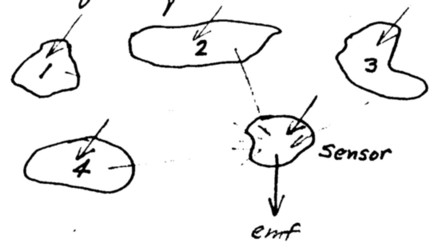
 Page 14
Page 14
In this case, the resonant sensor rock would respond to the total flux of the secondaries of all the adjacent rocks, but particularly that portion of
the total flux with which it is resonant. It would also respond to that portion of its own primary with which it is resonant.
In the above examples, I have referred to adjacent rocks. How adjacent? Will a large mass like a granite mountain at a distance produce the same
effect as a small granite rock close by?
And what about other materials than granite? What about lava, or clay or ocean water? This thing goes wild --- it gets more and more complicated.
Now, if the crust of the Earth generates secondary emissions and it comes from near and far and it comes from granite, marble, clay, ocean water, hot
magma and possibly even the core of the Earth itself, it is no wonder that the spectrum is so broad. And it is no wonder that various regions within that
total spectrum continuously shift up and down according t the relative intensities of these various secondaries.
I begin to see where it is a most complex phenomenon.
 Page 15
Page 15
Actually, one may say that the primary for any sensor is the complex blending of the secondaries of all masses of whatever nature anywhere within
range.
In the macrocosmos, one could then believe (for the same reason) that the secondaries of the stars, every star in the galaxy, bathes the Earth. One
could say that the primary striking the Earth comes from the secondaries of every other body (material body) in the Universe.
So far as the Earth is concerned, its primary is composed not only from the secondaries of the stars (near and far) but of all the planets, the moon and
the sun! The Earth then, as its part, re-radiates so that its secondaries travel outward to the moon, the sun, all the planets and the stars.
All matter in the universe must therefore be tied together in a vast network of primaries and secondaries, of incoming and outgoing radiant energy.
What is the nature of this radiant energy? Is it gravitational? Does it produce te force of gravity? Or is it something new, something which may never
have been discovered or even postulated? Is it limited to the speed of light or is it (as Newton postulated) "action at a distance" with infinite velocity?
 Page 16
184. A Communication System Using Secondary Radiation.
Page 16
184. A Communication System Using Secondary Radiation.
Honolulu, Feb. 11, 1975.
In the previous section, p. 11, it was proposed that masses receive what is termed primary radiation from the ambient and, upon saturation, re-radiate
secondary radiation. However, If electrical energy is generated in the process, and that energy is conducted away, the amount of re-radiation is
reduced.
In other words, the incoming energy must always equal the total outgoing energy, i.e., the electrical plus the secondary.
E
pri = E
sec + E
elec.
It would appear, therefore, that if one varies the electrical output, the radiation (secondary) output would vary inversely.
If one modulated the electrical output, the secondary radiation (whatever it is), would be modulated with inverted phase.

 Page 17
Page 17
If the secondary radiation of one mass, which is being modulated, becomes (in part) the primary of another mass, then it would seem that the electrical
output of the second mass would be accordingly modulated. Hence:

Therefore, it would appear that a communication system is possible, using secondary radiation as the transmitting agent. If that secondary radiation is
gravitational in nature, it would be very penetrating --- passing readily thru electromagnetic shields. This then would be a way to test the communication
possibilities as well as providing some clue as to the nature of secondary radiation.
We might call this "rock communication" since rocks would constitute the antennae of both the transmitter and the receiver. If the emission frequency
of the receiving rock and the receptive frequency of the receiving rock matched, the system would be tuned very much like a radio system.
 Page 18
185. Geophysical Regions as Active Emitters
Page 18
185. Geophysical Regions as Active Emitters
Honolulu; Feb. 15, 1975.
As we continue to get more data from the various sensors, it begins to appear that the variations which occur, and show up in the charts, would be
due to variations in the secondary radiation from land mass domains.
The whole idea that regions of the Earth’s crust emit some form of radiant energy is interesting, to say the least. This emission is not electromagnetic,
so far as we know. Of course, there is heat radiation --- secondary radiation from the sun, then conceivably fluorescence (from certain minerals and rocks)
as the secondary emission from sunlight.
The idea that there may be a type of re-emission or fluorescence from gravitational radiation from space is new. But I wonder if this may not be
exactly what it is.
If this is true, then the primary radiation from space account for the energy of excitation. Various regions (granite, lava, clay, perhaps sea water)
respond differently according to their resonance and each region emits its own characteristic spectrum. The intensity of each varies from time to time for
reasons which may become clearer as the research continues.
 Page 19
Page 19
The various sensors are resonant also and respond to the terrestrial region with which they are most closely tuned.
It has been suggested in one of the previous sections (Sec. 173, p. 140) that moving a sensor around in the automobile that various regions might be
mapped, perhaps even an isometric chart prepared:

If this is possible, what does the chart represent? Obviously, regions of greater secondary emission. But what are some of the factors affecting the
emission: moisture (the presence of water) or heat (possibly sub-surface temperature)?
Did the high readings over Kula represent high sub-surface temperature? If so, this may represent a valuable tool for locating geothermal reservoirs.
I shall conduct some surveys over the Koolau Dome area on Oahu.
Does this mean, if true, that the secondary emission of rock is a function of its temperature? Is this additional emission due to thermal energy
conversion? Or does the heat act catalytically, making the rock (or region) more susceptible to the incoming primary, so as to derive more energy from it?
Either way, the additional secondary emission is indicative of heat.
Considering that virtually all our sensors here in Hawaii show a definite diurnal pattern --- low at 6-7 AM and high at 6-8 PM, could this be ground
temperature? It is easily proved that it is not air temperature. How deep in the ground could such changes in temperature occur? The lag from air
temperature is quite understandable. Could the secular change be due to the variations in temperature of individual geothermal regions?
What about rainfall? Does ground moisture play a part --- either as water content or by its cooling action? Obviously, deep layers of earth or rock do
not change their moisture content rapidly. Something else must cause the sudden glitches. Could they be cosmic ray showers? Or some other unidentified
energetic radiation?
In summary so far, it now appears highly probable that our sensors are responsive to the secondary emission of various regions of the ambient matter,
rocks, sand, water, any dense mass.
 Page 21
186. Possibility of Indicating Geothermal Reservoir at Koolau Dome Site.
Page 21
186. Possibility of Indicating Geothermal Reservoir at Koolau Dome Site.
Honolulu; Feb. 18, 1975.
If granitic rocks generate an emf depending upon temperature (either by direct thermoelectric conversion or by increased gravitoelectric susceptance)
then what about lava rocks? Could the massive and dense (3.2 gr/cm
3) material making up the Koolau Plug radiate (increased)
secondary radiation because of its possible high temperature? Or is there a kind of Curie Point, above which such secondary emission is precluded?
Assuming that the Plug is hot, as evidenced by its lack of magnetization, could there be an increased radiation coming from that region above the plug
which is below the Curie Point? Only field tests will reveal the answer.

 Page 22
Page 22
One could argue, based on the sensor evidence so far, that there must be a gravitic "Curie Point". In other words, there must be a temperature (depending
upon the nature of the rock) above which secondary (gravitic) emission is not possible.
Otherwise the entire thickness of the Earth’s crust would be radiating with such overall intensity that it would mask the individual surface domains which
now appear so strongly. Even the deeper sections, even to the core, might be radiating unless precluded from doing so by some critical or cut-off
temperature.
Returning to the consideration of the Koolau Plug, if the temperature of the plug itself (connected to the deep magma below) is above the gravitic
cut-off, then no radiation would come from the plug. However, if the rock between the crest of the hot plug --- extending clear to the surface, is below
the cut-off, then it surely would be radiating.
Hence, if all this is true, it represents a geophysical tool to explore warm spots too deep to be detected by infrared aerial surveys. By pinpointing
the intermediate depth warm spots, one could predict regions of strong temperature gradients and, therefore, the existence of hot spots below.
 Page 23
Page 23
Laboratory tests should be conducted of secondary emissivity with temperature. It isn’t enough to merely heat a rock sensor and to determine its
emf output as a function of temperature. What we are talking about is gravitic emissivity from ambient rocks near te sensor rock.

In the above consideration, I have speculated upon the effect of temperature upon the secondary emission of ambient rocks or domains.
But domains (depending upon the type of material) --- granite, lava, clay, sand or possibly water --- differ in the characteristic spectrum of their
secondary emission. It is possible that spectral signatures differ widely, so that one may eventually be able to identify the domain by its spectral
signature.
But a change in temperature, or even moisture, could affect the signature, either to change the intensity or the spectrum, or both. No wonder the various
sensors reveal a complex of independent variables, considering that each sensor responds to its tuned ambient domains near and far away.
 Page 24
Page 24
These surely are not temperature related, but must come in to the various emitting domains from space as changes in the primary --- either as intensity
changes or spectral shifts.
Some glitches affect all sensors simultaneously, or within a few minutes. It is possible that the ambient domains respond differently to the primary
glitches from space, both as to resonant frequency shift and general intensity.
It would appear, therefore, that while the sensor itself may be responsive to these "space" glitches, it is more reasonable to believe that the sensor
mainly picks up the response (as secondary emission) of the ambient domains to said "space" glitches. The effect, therefore, may be one step removed.

The same indirect effect may apply to the secular variations which may also come in from space.
 Page 25
Page 25
[Missing]
 Page 26
Page 26
In summary, therefore, it may be said that ambient domains, emitting secondary radiation are tuned and have characteristic spectral signatures
which are picked up by a sensor similarly tuned.
Any sensor may pick up the combined radiation from a vast mosaic of domains of similar spectral characteristics.
At this point, it is believed that the daily (solar-driven) variations in the domain temperature affect the sensor, not the temperature of the sensor
itself.
The peaking temperature (phase) of the various masses comprising the domain are never precisely the same, but may vary over many hours --- hence, the
difference in peaking time (or phase).
Proximity of the sensor to its (resonant) domain is important as the action is presumed to fall off as a function of distance.
In the case of the Koolau Plug, resonant in a certain spectral band, we may have to try different sensors in order to find one with the same (or close)
spectral sensitivity. What would be different about the Koolau Plug, from the neighboring domains? Probably its density or its temperature.
 Page 27
187. Self-Potential Measurement in Relation to Potential Geothermal Reservoirs
Page 27
187. Self-Potential Measurement in Relation to Potential Geothermal Reservoirs
Earth-currents have been observed and measured over vast regions of the earth’s surface for many years. Much of this early work was performed by the
Carnegie Inst. during and prior to 1930 by O. Gish. Diurnal variations were consistently observed which seemed to be related to the Earth’s magnetic
envelope. Observations also bore correlation with solar flares, magnetic storms and auroral displays. There is quite a literature on this subject.
Continuation of these earth current measurements in Hawaii showed the existence of self-potential domains, as:

These domains appeared to be related to (or caused by high subsurface temperatures, thus indicating the probable locations of geothermal reservoirs.
No explanation, to my knowledge, has been advanced for the cause of this electrical potential. It has been thought to be caused by some (obscure)
oxidation process. But one may ask: oxidation of what?
 Page 28
Page 28
I am of the opinion, at this moment, that these self-potential domains are of the same origin as the domains as discussed in Dec. 185, p. 18.
Rocks within the domain must be generating higher emf than those in the surrounding area, hence an electrical gradient outward as shown in Fig. 1, p.
27. I understand that some of these self-potential gradients run as high as 900 mV. This is not incompatible with the emf produced by our individual rock
sensors. It may simply mean that the rocks below the surface are hot and that their gravito-electric (if that is what it turns out to be) conversion of
energy is greater.
I plan to take a portable EA recorder with a rock sensor in the automobile to the Koolau site this weekend, making continuous measurements in and about
the area. It is entirely possible that a telluric domain can be pinpointed and profiled.
 Page 29
188. Self-Potential in Geothermal Plugs as a Source of Commercial Electricity.
Page 29
188. Self-Potential in Geothermal Plugs as a Source of Commercial Electricity.
Honolulu, Feb. 22, 1975.
In the previous section, it was pointed out that telluric electricity, so-called self-potential, appears to be generated in hot geothermal domains.
The electrical gradient is outward, and in the same direction as the thermal gradient.
Hence, it would seen that if we placed a large electrode in the center of the domain and other electrodes in the periphery, and substantial current
might be observed, outward from the center. In other words, if we placed electrodes in regions of different temperature, currents would flow from the
hot region to the cold region.

Which means that electrons must flow inward toward the hot region. But where is the return circuit? Let us worry about that later.
In the meantime, one might generalize that the hot magma is positive, while the upper crust of the earth is negative.
 Page 30
Page 30
Or, that the top of a drill hole (into a geothermal reservoir) is negative, while the bottom is positive. If large enough electrodes were embedded at each
place, a commercially useful current may be obtained.

It is interesting to consider at this point whether the electrical energy is entirely converted from thermal energy or whether gravito-electric
conversion is partly responsible. As stated before, high temperature may increase the susceptance of rocks to gravitational radiation, so that more
gravitic energy is captured.
A test might be to look for glitches or secular changes typical to primary space radiation. Purely thermal conversion would depend only on temperature
differential and probably would be fairly constant.
 Page 31
189. Effects of Sensor Shielding.
Page 31
189. Effects of Sensor Shielding.
Honolulu, Mar. 3, 1975.
It has recently been noticed that when a shielded sensor (No. 16-GZZ-100) is removed from the vicinity (along side of) an unshielded (but Plexiglass
encased) sensor No. 17-DZZ-100 and 18-DZZ-1000, the two unshielded sensors increase emf output substantially. Obviously, they sense the presence of the
metallic (aluminum) shielded sensor alongside.
Two reasons or this: (1) a depressing effect resulting from interfering resonance, or (2) the effect of the adjacent metal case. I am inclined to
favor the latter explanation, as:

This could, of course, be the result of partial electromagnetic shielding --- provided by No. 1, if em radiation is causing the emf in No. 2 and 3. But
em radiation cannot explain the diurnal and other sensor characteristics. So let us consider something radically different and perhaps not considered in
contemporary physics. That is a kind of "ether" flow.
 Page 32
Page 32
If a critical flow of ether existed (in this instance), it may find greater conductivity (or permeability) in the metal. Hence, it would be diverted away
from the Plexiglass encased sensors. When the metal is removed, the flux would then increase in the two other sensors.
This may throw an entirely new light on the entire phenomenon. Could it be related to ether or ether flow? And it presents a new possibility in the
design of the resistor-type sensors, as follows:

 Page 33
Page 33
This hypothesis can be rather easily tested by inserting a large diameter rod in the center of the ceramic tube which forms the substrate for the large
resistor, such as the GZZ or DZZ series.
Rods of both light and heavy metal should be tested, say aluminum and lead. If we are observing a kind of gravitational flux permeability, there should be
a difference.
Just as magnetic flux follows an iron core, so possibly a gravitational flux follows a lead core. I wonder!
Magneto-electric/gravito-electric induction: Inductive windings generate an emf then the core is center. If a lead core is centered within a resistive
winding, would it be a parallel situation? Would it represent gravito-electric induction?
In looking back over the sensor records, I find an interesting fact:

 Page 34
Page 34
This seems to indicate that any kind of case (on the outside) reduces the emf output. The effect is the same as if it were only the result of
electromagnetic induction --- from ambient em noise --- but this does not seem to be borne out. It is not incompatible with an inductive hypothesis of
another sort, perhaps gravito-electric.
Another aspect of this finding and interpretation is that a sensor is influenced by the nature of its surroundings. In the apex, maximum readings
may be expected. When surrounded by heavy walls or large metal objects, the readings would be less. I believe this was borne out at the Haleakala
Observatory, where on one instance a sensor was attached to a steel column. Virtually no reading. Removed from the vicinity of the column, the reading
became normal. Hence, one might say that steel framing (in a building) reduces the readings of the sensors.
Hence a sensor may serve as a detector of neighboring masses --- a proximity sensor if you will. The greater the density or mass the greater is
the effect. But the mechanism of this effect is the action of the neighboring mass upon the ether flux (much as I hate to use that word --- nothing else
quite fills the bill).

 Page 35
Page 35
In Fig. 1, the flux lines are concentrated thru the sensor. In Fig. 2, the adjacent mass has "stolen" the field.
This brings up the possibility that certain "long form" sensors may be directional --- that is, respond when in the alignment of the flux. In the
previous Figs 1 and 2 the flux was assumed to be vertical. But what of a transverse or horizontal flux? Does flux density shift from predominately
vertical to strongly horizontal and back again? Is this the mechanism of the diurnal variation? Now, we must carry on some careful orientation tests.
Are we possibly talking about ether drift? I am no sure that there is no ether drift. Certainly, the long labors of Miller have never been contradicted
by valid experiment.
Assuming for the moment that ether drift does exist and that the movement of the Earth around the Sun, coupled with the axial rotation of the Earth gives
rise to the diurnal variations which we consistently observe, could we place a long sensor on an equatorial mounting and continuously observe the direction
of motion? I am inclined to think we could.
 Page 36
190. Regular Pulsations in Rock EMF Output.
Page 36
190. Regular Pulsations in Rock EMF Output.
Honolulu, March 10, 1975.
It has long been observed, both in the emf output of rocks and resistor-diode combination hat continuous rapid variations exist. These
variations have appeared to be mostly random, with a few instances where regular periods of several minutes to several hours have been observed.
A volcanic rock of about 10 cm diameter was picked up on the beach at Waikiki, oven-dried a 400 F, then after cooling, copper-print electrodes were
painted on (in the usual manner). Output was about 60 mV. But when connected to the EA recorder immediately showed a rapid regular pulsation of approx 1
second frequency. See Chart at left (1 sec marks). Also another frequency appeared of about 1/3 second pulse duration. Phase shifting complicated the
pattern.
This is the first time, to my knowledge, that rapid regular pulsations have been observed.
Now, the big question is, what is the source? Other rocks picked up the same day do not show this pattern. Hence, it is not in the recorder circuitry,
but comes from the particular rock.

 Page 37
191. Augmentation of Output by Sand Cores.
Page 37
191. Augmentation of Output by Sand Cores.
Honolulu, March 16, 1975.
In Sec. 18, it was suggested that by using cores of heavy material, the output of resistive sensors could be increased. Lead and aluminum rods, as
cores within DZZ resistors, were suggested. This might give some clue as to the so-called gravitational permeability, or (if you will) ether flux.
An experiment has (this day) been conducted which may relate to the above. One of the recently acquired resistors (DZW-100 megaohm) was filled with beach
sand from Kuhio Beach.
Tested both before and after filling, revealed substantial gain in emf output with a sand core.
Could this mean increased grav. permeability or could it mean proximity to a re-emitting mass as discussed in Sec. 183?

 Page 38
Page 38
This experiment raises the question as to the effect of other core materials:
(1) Other beach sands. Black (lava) sands.
(2) Clay --- Bauxite --- Sandusky clay.
(3) Monazite sands (from various places.
(4) Lead monoxide (litharge).
(5) Lead monoxide and glycerine compound.
(6) White silica sand.
(7) Molding sand (with clay content)
(8) Carborundum or alundum.
(9) Powdered metals, lead, aluminum, etc.
(10) Iron filings.
Or various liquids:
(1) Water, sea water.
(2) Alcohols.
(3) Carbon tetrachloride --- heavy non-conducting liquids.
(4) Oils (mineral and vegetable).
(5) Waxes --- paraffin, carnauba, etc.
Or solid metal cores:
(1) Non-magnetic and magnetic.
(2) Ferrite.
(3) Rock cores, granite, lava, etc.
 Page 39
Page 39
It appears to be quite definite, at least in the instance of the first test with Kuhio Beach sand) that the emf output increased from approx 63 mV to over
115 mV and still rising! There is no question that the sand core did increase the output of the sensor.
Now, the next question is: Is this due to re-emission (secondary radiation) from the sand? If it has a frequency spectrum, is it related to the
spectrum of the entire Kuhio Beach area? What is the diurnal pattern? Could it be affected by the temperature changes of the Kuhio Beach area? These are
interesting and perhaps very important questions.
If the answer can be related to the area from which the ore material is obtained, we may have an important geophysical sensing tool. Of course, the
porcelain tube (substrate) of the resistor may have its own contribution and this must be taken into account.
By this same reasoning, a rock sensor may be related to the area from which the rock came. Granite rocks from granite areas. Lava rocks from specific
volcanic areas. One wonders about liquid cores. Could a salt water core be related to the body of ocean water?
 Page 40
192. Possible Cause of the Weber Events.
Page 40
192. Possible Cause of the Weber Events.
There is a growing belief that the so-called "events" observed by Joseph Weber in his gravitational radiation detectors are not due to oscillations of
the large aluminum cylinders. The very nature of the electrical impulses from the strain gauges does not appear to resemble the kind of thing one would
expect from a "ringing" cylinder. If shock excited, the cylinder would engage in decremental excitation, as:

at the resonant frequency --- 1661 Hz or 1580 Hz, as the case may be.
However, the events indicated by resistance changes in the strain gauges do not show this decremental pattern, but something quite different.
It leads one to believe that the events are not indicative of cylinder oscillations but of some effect arising within, or related to the electrical
circuit.
Hence, one must look to resistive changes or to voltage "bursts" in the resistive materials.
 Page 41
Page 41
This brings to mind that the effects observed and reported in the previous section (191) and in 189 may be responsible for the Weber events.
If resistive material lies adjacent to a large mass, is it possible that the secondary emission from the mass could affect the resistance?
In the case of the sand core experiment, it seemed clear that the presence of the sand affected the output of the sensor. If the sand were replaced with
a mass of metal, such as aluminum, would there be similar, or even greater, augmentation?

This is precisely the arrangement in the Weber experiments.
A better arrangement might be to surround the mass with resistive material (preferably non-inductive).

 Page 42
Page 42
Or, using Weber-type cylinders, simply attach sheets of resistive material, of 100 megaohm or more, to the sides of the cylinder, just as the strain
gauges are attached.
The only difference would be that large high-resistance non-inductive sheets are used instead of the comparatively low-resistance strain gauges.
Then using also diodes for rectification of the RF induced in the sheets.
Other large masses may be used even more effectively. It need not be an expensively machined cylinder. Any large hunk of material would serve as an
emitter. Perhaps, even a mountain.
It is all based on the belief, at this point, that radiation from space (gravitational or something else) is the primary --- supplying energy, and
that the mass engages in fluorescence, emitting a secondary which generates RF noise in neighboring resistive material. The spectral band of the secondary
may be quite different from that of the primary, depending upon the composition of the re-emitting material and its temperature.
T.T. Brown (3-18-75). (I am 70 years old today).
 Page 43
193. Storage of Electricity in Rocks.
Page 43
193. Storage of Electricity in Rocks.
Honolulu, Mar. 24, 1975.
Rock sensors act as storage batteries and may be charged. Just how long the charge remains varies with the particular rock. Rocks in series are able to
store a higher voltage.
In other words, rocks have a very high (natural) capacitance. More than capacitance, it seems to be in the nature of a persisting excitation. So long
as the excitation persists, the voltage sustains.
Thus, it is not simple capacitance depending upon the dielectric constant of the dielectric but something else, a form of excitation which requires an
energy input and then decays. This decay is far slower than if the effect were merely capacitance.
This difference (from ordinary condenser action) is clearly noted when the rock is shorted. When the short is removed the potential returns to a value
almost as great as before the short occurred.

 Page 44
Page 44
In this respect it is similar to electrets which may be shorted and then return to normal when the short is removed. Hence, we may again refer to rocks
as geo-electrets (Sec. 172).
There is this difference. Carnauba wax electrets retain a high voltage but can support virtually no current. Geo-electrets seem to be able to support
large currents, depending upon the size. Large rocks may conceivably provide substantial current.
This places the geo-electret in the class of a chemical cell or storage batter, and may, as a matter of speculation, find an application commercially
as an energy storage means.
One may picture large blocks of granite, connected in series, as equivalent to storage batteries --- with the advantage of not requiring service or
replacement and conceivably having indefinite, unlimited life.

 Page 45
Page 45
If this is true, and it seems to be what of the great pyramids? Can the atmospheric electric gradient charge the pyramids? Has anyone measured the
potential difference between the cap and the base of Cheops? What of the pyramid shape? Is it significant?
 Polarization:
Polarization:
Does all this mean that rocks become electrically polarized by the application o a field? Does the rock contain molecular dipoles which become
oriented? Similar to becoming magnetized, can a rock become electrolyzed? Is there an electrical Curie Point, above which polarization is lost?
Let us take, for example, a large flat surface of the earth’s granitic crust, apply a positive charge at the center so as to establish a radial
field.

 Page 46.
Page 46.
This then becomes a radially polarized electrical domain. Measurements of the so-called self-potential of this region would establish the existence of
such a domain. Can this pinpoint the presence of subsurface heat? Apparently, it is believed that it can.
This would infer that the hottest region is positive and that the heat gradient and electric gradient are parallel. Hence, in the case of the Koolau
Plug, the central region of the plug is positive while the periphery is negative.
This charge retention in rocks, perhaps also in many solids (crystalline and amorphous), may be due to dipole orientation. A gradient or field probably
aligns the constituent dipoles, so that a net potential difference results. The greater the number of aligned dipoles, the greater is the net potential.
But the alignment decays, as individual dipoles flip to random positions. Hence, the net voltage drops.
Thermal agitation would appear to hasten this decay. Hence, the higher the temperature the more rapid the decay. At some temperature (as with the Curie
Point in magnetism) dipole orientation cannot be maintained and the net charge would disappear.
 Page 47
Page 47
Conversely, at lower (cryogenic) temperatures, the net charge may possibly be retained indefinitely. This, I believe, is true with electrets generally,
although certain electret waxes (of very high resistivity) maintain charge for long periods of time.
Going forward with this thinking, one might say that the (natural) residual charge of a rock may be wiped out by heating to a certain temperature which we
shall call the Electrical Curie Point. Then apply a high electric gradient to the rock as it is cooling, possibly to some cryogenic temperature where the
charge persists without decaying. The stored energy would have come from the applied field. Could it be removed by shorting or an electrical load?
Or would there be a replenishment of that charge thru the mechanism of primary and secondary radiation, as discussed in the earlier sections?
Is it possible that a newly-acquired rock sensor must be polarized to be sensitive to the incident radiation? Does the degree of polarization affect
the spectral band to which the rock responds? Can one change the circadian signature of a sensor by applying a field or gradient? This may be possible
with rocks but why would it be effective with the so-called synthetic rocks --- resistor, diode, capacitor sensors where dipole orientation seems
inappropriate.
 Page 48
194. Initial Electrical Polarization.
Page 48
194. Initial Electrical Polarization.
Honolulu, April 1, 1975.
It is believed that the storage of electricity in rocks is the result of polarization, i.e., the alignment of electric dipoles within the body of the
rock. When a field is applied, the dipoles are aligned and this energy is retained by that alignment.
As the alignment decays, the charge decays also.
Initial alignment may result from atmospheric gradient, as suggested in Fig. 3, p. 45. This may account for the seemingly valid observation that the
upper side of rocks (such as those picked up on the beach) are positive. This may also be accounted for as gravito-electric induction. Perhaps even the
atmospheric gradient is the result of gravito-electric induction.
Recent tests, where a field is applied to initially polarize a rock show a phenomenal reversal of initial polarity.

 Page 49
Page 49
The mechanism here is certainly not understood. It seems to take place with all rocks.
195. Sand Sensors.
Volumes of sand, in insulated containers, act as rocks. This is probably to be expected. Sand grains in contact with each other actually form a series of
dipoles.

Here, too, the original polarizing charge decays and reverses, as in Fig. 1. Variations, diurnal and secular, occur then in the reversed charge.
It is believed many granular or powdered materials behave in this way. Tests are proposed with litharge, silica sand, monazite, black lava sand,
barium titanate powder, clays, coral sand, etc. Is it a function of mass and/or dielectric constant?
 Page 50
196. Gravity Vector Sensors.
Page 50
196. Gravity Vector Sensors.
Honolulu, April 2, 1975.
In Sec. 144, Notebook 3, dated 2-7-74, reference is made to the interaction of the gravitational and electric fields. It was pointed out that the
atmospheric electric field, the mountain effect, and similar vertically-oriented electric fields may be caused by the gravitational field
of the Earth.
This reference goes on to suggest a possible gravity-vector instrument useful in space navigation. It describes such an instrument in Fig. 4 (p. 66),
based on the belief that the upper end o a vertical resistor is positive with respect to the lower end.
In Sec. 170 (pp 133 and 134), the electrical polarization (possibly by the gravity flux) was extended to include rocks and grains of sand.
Gravito-electric induction was again proposed in Sec. 171 (9-14-74). Improved sensors for gravity-flux were described (p. 139, Fig. 1) where beach sands, or
loess, would be settled in a fluid. During settling, the individual sand grains would have an opportunity to orient before compacting. Hence, a
permanent geo-electret would be formed. Such a sensor was illustrated in Fig. 1, p. 139. In every case, it is believed that the positive end of the sensor
will be up, and negative down.
 Page 51
Page 51
In an experiment performed today, Kuhio Beach sand was paced in a Plexiglas tube with electrodes at each end, as:

Immediately, the upper electrode became positive. Voltage approx 60 mV.
When the tube was inverted, the upper end again became positive, at about the same potential.
Hence, it again pointed up the relation of electrical polarity wit the gravity vector. It is a difficult phenomenon to explain in terms of
contemporary physics. To my knowledge no known electrical manifestation is related to gravity with the possible exception of the orientation of polar
molecules in florigen/heterauxin which seems to be responsible for the vertical growth of plants.
Now, the next question arise: what of centrifugal fluids? Is the effect, as in Fig. 1, responsive to inertial fields? Is there equivalence between
inertial and gravitational mass, or is somehow an exception?
 Page 52
Page 52
Only future tests will reveal the answer.
Today, most of the recording equipment, including the digital data logger was moved to the basement, constant temperature seismic vault of the Hawaii
Inst. of Geophysics. Recording was started at 1600.
The vertical sensor is still at my apartment in Waikiki. I shall move it to the University tomorrow. I plan to place it on a trunnion mounting, so as to
invert it conveniently. As:

Using a digital VTVM or equivalent to read voltage and polarity.
In the above experiments, it is important to electrically shield the Plexiglas tube from electrostatic gradients in the ambient. Ideally, the tube
should be placed within a grounded metal case which is attached to the trunnion support. Shielded cables must be used also. Observations should be
made as to whether the maximum voltages occur in the zenith-nadir alignment (as it should be if it truly gravity flux) or whether, if mounted
equatorially, it might indicate some contribution by a cosmic field.
 Page 53
197. Electric Dipole Rotation.
Page 53
197. Electric Dipole Rotation.
Honolulu, April 3, 1975.
In the previous section, vertical dipole induction from the gravity gradient was discussed. Crystalline materials, such as rocks or grains of
sand, were considered. It was discovered that the sand sensors were superior to rock sensors for detecting the gravity vector.
The mechanism is not clearly understood at this point, but it is believed that dipole rotation may be responsible. Sand is better than crystalline rock
possibly because the resident electric dipoles may rotate more freely.
It is now suggested that amorphous materials and fluids, especially liquids, which have high resistivity, density and dielectric constant, may be
better than sand. An insulated tube filled, let us say, with carbon tetrachloride or bromine or acetylene tetrabromide may allow rapid orientation
of resident dipoles. Since high resistivity appears to be required, liquids with ionic conduction would not be suitable. Liquids with suspended powders
may also be suitable. Matching the density of the liquid to the powder would help to keep the powder in suspension.
 Page 54
198. Sensors in Vertical Series.
Page 54
198. Sensors in Vertical Series.
Honolulu, April 13, 1975.
Various circuits have been tried, with more or less success, putting sensors in series order to build higher voltages. Strange effects occur which
make the results disappointing. After a time, some of the sensors go negative (reverse their polarity) so that the total voltage is not sustained. This
seems to occur not only with resistor-diode-capacitor sensors but also with rock sensors in series.
The reason for "going negative" when related in a circuit with other sensors is certainly not clear.
A slightly different circuit is suggested:

 Page 55
199. Effects of Ambient Temperature.
Page 55
199. Effects of Ambient Temperature.
Honolulu, April 15, 1975.
For some time, there has been conflicting evidence as to the effect of temperature, not only upon the resistor-diode-capacitor sensors, but also upon
the rock and piezoelectric types.
There appears to be some complex temperature dependence upon the sensor itself, but there are instances where the actual sensor temperature is
constant and the (remote) ambient temperature changes --- producing a change in output.
In other words, a sensor might indicate a temperature change of a remote medium and yet (itself) remain at a constant temperature. The "remote" medium
may be air, or, conceivably, it could be masses of rock, sand, or water. It could be termed a remote-sensing pyrometer, almost like an optical pyrometer
except that no part of the pickup changes temperature.
This may turn out to be a phenomenon related to secondary radiation (see. p. 23). If the neighboring radiating mass is warmed, it could radiate more
(scalar increase) or it could increase the radiation frequency. This could be entirely a remote-activated effect. The sensor itself need not change
temperature.
 Page 56
Page 56
There have been several striking instances which point to this conclusion.
(1) Sensors operating in constant temp. conditions (cabinets) sense the temp. variations of the environment.
(2) Sensors in boxes of large thermal inertia sense rapid changes in the ambient temperature.
(3) The entire phenomenon of diurnal variations, where sensors are heat-shielded.

Air (atmospheric) probably has the greatest (diurnal) effect, although soil, sand or surface rocks may contribute to a daily temperature effect with
different phasing.
Could this explain the various diurnal pattern (circadian cycles) which are observed?
 Page 57
200. Electrically Polarized Materials as Sensors.
Page 57
200. Electrically Polarized Materials as Sensors.
Almost from the beginning of this research, as early as 1927 at Janesville OH, massive high-K dielectrics have been used. At the naval Research Lab
(1931-33), the assigned official project was "The Anomalous Behavior of Massive High-K Dielectrics".
Various massive high-resistance materials were tested. At Janesville, powdered lead monoxide (litharge) was mixed with molten paraffin (or beeswax)
and cast into blocks with electrodes cast on opposite sides. These were called "molecular gravitators".
When these blocks were free to move, either as a pendulum or on a rotary support, and charged to 150-300 KV DC, a mechanical force developed which
moved the block in the direction neg to pos. The force varied with time even though the applied emf was held constant. This force appeared to have solar,
lunar, and sidereal periodicities which was subsequently studied (over the years) in great detail.
Other materials such as lead monoxide and glycerine (chemically reacted), marble, lead monoxide in bakelite binder, were tried with varying success.
 Page 58
Page 58
In later years, when high-K dielectrics as used in ceramic capacitor, were developed, attention was directed toward barium titanate and the like. As
piezoelectric technology developed, other suitable materials came into being.
Today, various piezoelectric products such as those put out by Clevite Corp. (Cleveland) are on the market. Most of these materials are truly massive
high-K dielectrics. Great progress has been made in the last 40 years, since the time of the project at NRL.
These new piezoelectric materials are "clay-like" substances which are molded like potters clay and fired. During the firing, a high voltage field
(DC) is applied which aligns the natural dipoles and provides a (more or less) permanent polarization, thus making an "electret" capable of retaining a
potential difference for a long period of time.
Such an electret, like the earlier classic electrets of carnauba wax, will not support an electrical load. The voltage drops to zero, but recovers again
when the load is removed.
Polarized piezoelectric transducers are used in submarine signal applications, sonar, etc. Polarization is needed for in-phase coupling.
 Page 59
Page 59
The literature on the subject is extensive, but there is still some uncertainty as to the factors which affect the behavior of piezoelectric
materials. In the following paragraphs, I shall point out some interesting observations which may (or may not) be related to gravitational radiation.
(1) In the first place, these materials are truly massive high-K dielectrics. Barium titanate is one of the heaviest. Its dielectric constant,
in some cases, is over 20,000! And it has very high electrical resistivity.
(2) The polarization life is quite long, and for practical purposes virtually steady. Minimum decay.
(3) It is an ideal material for intercepting gravitational radiation over a broad band, converting the energy of the gravitational radiation into an emf.
(4) Each constituent dipole acts as a gravito-electric converter, resulting in an increase in dipole gradient and total charge.
(5) The total charge of each dipole is additive along the alignment of dipoles so that total polarization (emf) is increased by the incident gravitic
radiation.
(6) Hence, there is a certain seeming parallel between piezo-electricity and gravito-electricity. The reasoning is this:
 Page 60
Page 60
(a) In a photocell, incident light (em radiation) falls on a surface of material which emits electrons (classic photoelectric effect). The electrons
are driven (energetically) to a collector electrode nearby. The collector becomes negative whereas the emitting surface becomes positive. Here is then
an electric gradient, a polarization, or, if you prefer, an increased polarization.
(b) In a gravitocell, gravitic radiation penetrates thoughout the volume of a polar material, causing one of the constituent poles to emit electrons which
are energetically driven to the other pole, leaving the first pole positive and making the second pole more negative, thus increasing the polarization or
total emf.
(c) It must be borne in mind that the photoelectric effect is essentially a surface effect --- being the surface exposed to the incident light. Electrons
are ejected from various distances below the surface, governed by the light absorption constant of the material, possibly from the Fermi level. The
displaced electron (caused by photon absorption) travels through the crystal lattice to the surface. This travel to the surface requires energy and is
called the work function.
 Page 61
Page 61
(d) There is a distinct relation between the frequency of the light and the generated emf. Einstein’s equation is h ( v – v
o ) = eV where h =
Planck’s constant and v the frequency.
(e) The action of a gravitic quantum or graviton is similar to that of the photon. The action, however, occurs not just on the surface or near the
surface, but throughout the volume of susceptable material. It may be termed ponderomotive in that it acts throughout the volume or mass of material. Rock
sensors are examples. The electrical energy is generated throughout the entire volume of the rock, not just on the surface.
(f) High density of the receptor material appears to be a factor. The greater the mass, the higher is the graviton capture rate.
(g) High dielectric constant (high-K) may serve several functions: (1) to slow up the incident graviton so as to facilitate capture; (2) to concentrate
the generated emf, or, (3) to store energy.
(h) In the case of a barium titanate sensor, it seems reasonable to assume that the heavier part (Ba) is the electron emitter and therefore positive.
 Page 62
Page 62
The receptor would be the titanate half and the negative side of the dipole molecule. As in the case of a photocell, escape energy from the barium atom
may be required so that work function would again apply. Alloys with cesium might lower that work function, or, as is the case with certain
semi-conductors, intermetallic compounds such as Cs3Sb or Na-K-Cs-Sb, or other impurity states could lower the work function.
This may account for the observation that certain rocks, for example, granitic or lava rocks produce higher outputs. Impurities may be desirable.
(i) Since electromagnetic and gravitic radiation are closely related, the energy is directly related to frequency (hv = eV). Hence, the higher frequency
bands of the gravitational wave spectrum are the more energetic, and probably have the greater effect on the sensors. Frequencies equal to those of light
(especially blue and above) may be the most effective. Possibly gravitic frequencies may extend to those of x-rays or gamma rays.
(j) There is a theory that electromagnetic radiation from a dense star, passing through a fixed magnetic or electric field (surrounding the star or in
the path of travel) will be slowly (gradually) converted into gravitic radiation. Hence, gravitic radiation, of the same frequency as light, may be
present. One could thing of red, yellow, green, blue or violet gravitic radiation, with wavelengths expressed in Angstrom units (8000 to 4000A) as may
be the case.
 Page 63
Page 63
There would seem to be the possibility that monochromatic lines exist or other typical spectral configurations.
(k) If such conversion actually takes place, i.e., from em to gravitational (at the same frequency), the residual light (not fully converted) must have
lower energy than it did at the start --- hence, appear shifted to the red. Could this account for the cosmological red shift or the as yet unexplained
redshift of certain stars or clusters?
(l) If this conversion is true, the total gravitic radiation in the band from 4000-8000 A must be great. Could it equal or exceed that of light?
(m) Hence, rock electricity from cosmic gravitic radiation may be homologous with photoelectricity from starlight or sunlight. Gravitoelectric
and photoelectric conversions are parallel and the instrumentalities are similar. Both emit electrons (which are captures) by gravitons in one
instance, photons in the other. Both convert energy.
(n) The term "white" gravitic radiation may have real significance, as a cosmic energy flux.
 Page 64
Summary:
Page 64
Summary:
This section sets forth the parallelism of gravitic and em radiation throughout the entire spectral range. The hypothesis suggests the existence of
gravitic radiation of the same frequency as light, extending possibly to x-rays or gamma rays. The lower end of the spectrum, the RF and sub-RF, has
already been suggested by Press and Thorne.
Methods of detection are believed to be similar. Gravitons cause emissions of electrons from emissive materials, just as photons do. The gravitoelectric
effect parallels the photoelectric effect. The gravitocell is similar to the photocell. Both are energy converters.
The gravitocell is volume dependent while the photocell is surface dependent.
Many natural materials are gravitocells, such as granitic rocks or siliceous sands, lavas, or clays. Polarization is important, so as to direct
electron emission, Otherwise, emission is random and no net field or current can be generated.
In a gravitocell, electron emission is facilitated by heating, hence it is somewhat temperature dependent up to its Curie Point. Impurities (certain
semiconductors) may reduce the work unction, causing increased eV.
 Page 65
Page 65
Piezoelectric materials with high polarization appear to be desirable because of the "field" needed to direct the electron emission. This field is
internal.
Polarization aligns the dipoles within the gravitocell. During electron emission each dipole increases its potential difference, and since the dipoles
(aligned) are in electrical series, the net emf of the series increases. Electrodes are at the ends of the series of internal dipoles.
A reverse action may also take place during electron emission. Since the emitted electrons fall through the fixed field, the positive pole attracts the
electrons, tending thereby to reduce the fixed field. This could cause, and does appear to cause, polarity reversal in the output. Very strong
polarization is suggested to prevent such reversal.
Electron emission may conceivably be directed or influenced by a magnetic field. Direction would be at right angles to the field. This will be the
subject of a further section.
 Page 66
201. Quasi-Luminous Gravitic Radiation.
Page 66
201. Quasi-Luminous Gravitic Radiation.
Honolulu, Apr. 19, 1975.
This is an extension of the hypothesis developed in the previous section. It concerns the idea that the broad spectrum of natural gravitational
radiation extends beyond the range considered by Press and Thorne (p. 342,
Gravitational Wave Astronomy).
These authors consider the spectral region from ELF to VHF. The concept presented here concerns the extension into quasi-luminous regions expressed in
Angstrom Units, i.e., 8000 to 4000 A.
One reason for this belief is that theory exists in the literature today that em radiation (including light from stars) may be gradually converted into
gravitational radiation (of the same frequency) while passing through static electric and/or magnetic fields which exist around certain stars or in
galactic space.
Such conversion must generate (if it exists) substantial amounts of quasi-luminous gravitic radiation throughout space. Our eyes cannot see it for
the reason that our photosensitive receptors do not capture it.
It is interesting to note that such conversion of the visible light from certain stars to gravitic radiation reduces the energy of the residual visible
light, causing a redshift of that residual light.
 Page 67
Page 67
Is it possible that the anomalous redshift, observed in the light from certain star clusters, is not due to Doppler recession (as previously
generally supposed) but to the energy depletion resulting from this conversion?
It may point up the existence of a substantial flux of quasi-luminous gravitic radiation throughout all cosmic space.
Such radiation would have enormous penetrability, whereas light does not.
This penetrability permits gravitic "light" to penetrate throughout large volumes of heavy masses. If the method comprising such masses is
electron-emissive through graviton capture --- just as photosensitive material is electron-emissive through photon capture --- a flux of free electrons is
created. If a field exists to direct a flow of these free electrons, an electric current is created. This electrical energy is derived entirely from
the incident gravitic light.
The so-called "rock electricity" may result from such an energy conversion.
Since the eV so derived is a direct function of frequency, and rocks may vary in functional resonance, various rock specimens may be responsive to
various spectral bands and output phasing (in their circadian rhythms) may be quite individual.
 Page 68
Page 68
In other words, certain rocks may be "green" sensitive, certain others "red" sensitive. And the incident radiation may vary as to green-red balance.
The broad background radiation may be termed as white, but it could become reddened or blued in irregular (secular) or diurnal patterns.
Photocells (solar cells) convert light (visible and IR) from the sun. This is a practical source of electrical energy.
Gravitocells convert gravitic light into electrical energy, but the source is galactic, not just the sun. It is possible the sun may contribute to the
total flux. This possibility requires further study. The thought here, however, is that this represents a new and untapped practical source of
electrical energy if true.
The structure of photocells is technically fairly well understood.
The structure of gravitocells may be closely parallel. It is because of this parallelism that theory and practical development may "hang its hat".
If quasi-luminous gravitic radiation is a valid concept and if the flux density at the Earth is adequate, it could represent an alternate source of
much-needed energy of practical proportions.
 Page 69
202. The Structure of the Gravitocell.
Page 69
202. The Structure of the Gravitocell.
Honnolulu, Apr. 19, 1975.
Gravito-sensitive materials bear the same relationship to gravitic light as photosensitive materials bear to ordinary light. Both are fundamentally
electron-emissive.
The photoelectric effect is primarily a surface effect (or a variable short distance under the surface). Incident photons penetrate to the conductor band
relatively close to the Fermi level within the atom. In semi-conductors, penetration is largely to the valence band. Electrons are emitted (dislodged
by the photon) which migrate through the lattice to the material surface. There they may be captured by an electrode which, thereupon, becomes
negatively charged. A current can be generated between the main body of emissive material and this electrode.
In photoconductivity, the action is similar. Free additional carriers (mostly electrons) are generated when photon energies are absorbed in
electronic transitions. Electrons are excited from a filled (atomic) band to a conduction band. Electron holes are injected into the valance band. At thermal
equilibrium, photoconductivity depends on the energy of the incident photons.

 Page 70
Page 70
In both photoelectric and photoconductive phenomena, photons kick electrons loose.
In gravitoelectric phenomena, gravitons also kick electrons loose, but the penetrability of gravitons permits the increase of free electron flux
throughout the mass of the conductive (or semiconductive) material which absorbs the gravitons.
Gravitic radiation (let us now think of it as principally gravitic light) is highly energetic but almost perfectly penetrating. It has been said that
such radiation is as penetrating as neutrinos! Nevertheless, it is almost perfectly penetrating, not perfectly penetrating. Mass (high density
materials) keep it from being perfectly penetrating. Absorption is a function of mass.
Heavy materials would, it would appear, capture an unknown small portion of the ambient graviton flux, but the energy represented by that small portion
may be substantial.
Predicated, therefore, on this possibility, graviton capture is assumed. Gravitons (sub-quanta) with energy of gravitic light may be extremely
energetic. Their absorption is believed to be capable of electron emission or electron-hole formation.
The thrust of all this is that electrical conduction (generally) may be affected.
 Page 71
Page 71
This may be termed gravitoelectric conduction or gravitoelectric conductivity. It would be parallel to photoconductivity.
All conductors would be subject to this phenomenon, which would be observed as a change in resistance. It would appear that the more massive conductors
would be the more vulnerable. The drop in resistance (caused by graviton capture) would be a function of mass.
However, this may not be strictly true and might depend on electron hole recombination rates and other factors not related to mass.
The simplest form of gravitoelectric sensor may be a length of wire which is carrying a current. See Sec. 123, Notebk # 3 (1973. Effects would be
observed as a change in resistance.
Any semiconductor may show the same effect. Biased high resistance conductors seem to show an additional effect by acting as an electromotance,
i.e., generation of a current. In such a device, the energy of the absorbed gravitons is converted into electrical energy in almost the same way as
photons convert into electrical energy.
 Page 72
Page 72
If the ambient flux of gravitons changes the population of electron hole pairs within a conductor and the net movement of the charge carriers is
directed, a usable current is generated.
Charge carriers may be directed by (1) An electric gradient (bias); (2) A magnetic field; (3) A gravity field (such as the Earth’s gravity field).
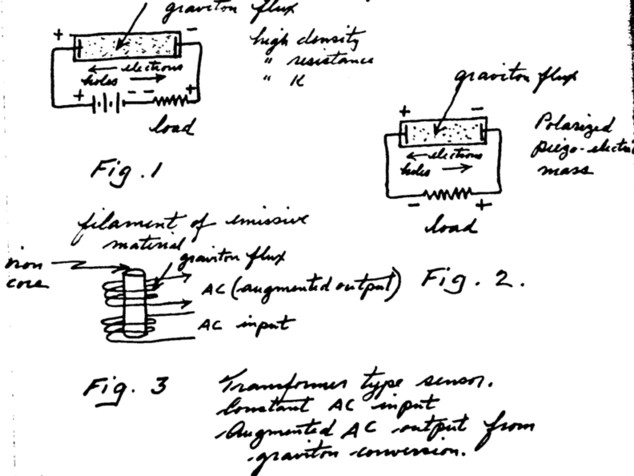
 Page 73
Page 73
In Fig. 1, polarization is supplied by an HV external battery. Graviton-induced emf is counter to this polarization if electrostatically
induced. If current-induced, it is augmentative.
In Fig. 2, polarization is built into the emissive material. An electrostatic field is established within the mass. Graviton-induced charge
carriers tend to migrate in the direction of the field, tending to reduce the field, thus decreasing the polarization.
In Fig. 3, the alternating magnetic flux drives the graviton-induced charge carriers (as well as the free resident carriers) so as to increase output
current.
This is a new type of sensor. Its output is AC. If RF driven (without core), the output would be augmented RF.
Figure 4:

 Page 74
203. The Effect of Increasing Bias.
Page 74
203. The Effect of Increasing Bias.
Honolulu, April 21, 1975.
In the previous section, it was proposed that additional charge carriers (pairs) are created in massive dielectrics by the absorption of gravitons, an
effect similar to pair creation in photoemissive materials by photons.
The difference lies in the difference in penetrability of gravitons and photons. Gravitons easily penetrate thru the massive material, whereas photons
penetrate only a short distance below the surface. In the case of photoelectric emission of electrons, the electrons lose energy in escaping
thru the crystal lattice (work function). In photoconductivity, it is the change in conductivity which results, rather than the emission of electrons.
The effect of gravitons is presumed to be on conductivity primarily. Electron hole pairs are created throughout the body of dense dielectric
material. Recombination takes place rapidly unless a field (or current flow) exists. In such case, the additional charge carriers increase the
conductivity.
It would appear that a relationship exists between the current and the conductivity, i.e., the greater the current, or bias, the greater the
conductivity.
 Page 75
Page 75
These would be less time for recombination, or at least the rate would be lower.
In summary therefore, gravitocells should be biased, either by a current flow or by an electrostatic field (electric polarization) or em induction.
Fig. 1, p. 72 illustrates the use of current.
Fig. 2, the use of polarization, and
Fig. 3, electromagnetic induction.
Fig. 4, high-freq. induction.
It is recalled that the first gravitic sensors were believed to be operative because of a change in resistance. Resistance bridges were used,
having arms of resistive material of different density.
Later, resistors (>100 megaohms) were used, together with a diode. It is now seen that the diode (once AC was intercepted) provided the flow and the
bias, which was then augmented. The establishment of the bias in rocks is not as yet understood. Once established, however, it could be sustained.
But the purpose of this section is to point up the need, even with rock sensors, to use a battery to provide a reliable constant voltage bias.
 Page 76
Page 76
An experiment is in progress today which, I believe, adds weight to this thinking. As follows:
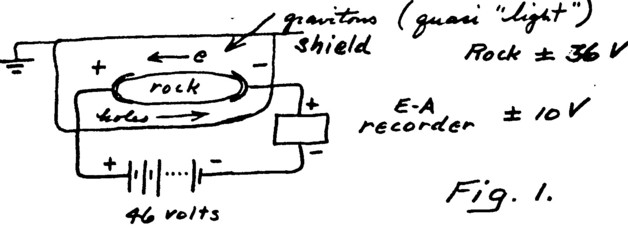
The circuit actually measures the conductivity of the rock, but it provides the rock with a bias. Graviton-created charge carriers (electrons and holes)
add to the normal conductivity. Variations in gravitic flux are readily observed as a change in conductivity.
It is noted that conductivity increases at noon each day, hence it is an indication that the flux increases at noon. It does not appear to be
temperature dependent.
Does this mean that the sun is a source of gravitic light as well as em light? What of gravitic heat --- slightly lower frequency? If this is so,
would it represent an alternate source of energy?
 Page 77
204. High Voltage Bias and Energy Extraction.
Page 77
204. High Voltage Bias and Energy Extraction.
Honolulu, April 2, 1975.
In the previous section, the biasing of rock sensors was discussed. It appears that the sensitivity (receptivity) or rock sensors to gravitic
radiation is increased as some function of bias voltage. In an experiment currently underway a 45 V "B" battery is used. Diurnal sensitivity appeared to
increase 10-fold over that of the normal which resulted from the rock’s natural self-potential.
The thought, therefore, extends to the use of higher voltages. What would be the result?
With the setup as shown in Fig. 1 (p. 76), voltage across the rock ranges from 35.0 V at noon to 36.0 V during the night. Incoming radiation appears to
reduce the rock bias, by lowering the resistance of the rock. This voltage variation is not steadily or smoothly changing; it is highly erratic, possibly
noisy. Extraction of energy may be possible by rectifying this noise, as:

 Page 78
Page 78
An alternate circuit which may give interesting results is:

What sounds will be heard, if any? Perhaps the coupling transformer should be RF along with the amplifier. Will the voltage output of the RF transformer
represent the incident gravitic radiation? Can it be recorded on a strip-chart recorder?
If resistors (100 megaohm or above) are substituted for the rock and constant voltage HV supply (possibly 10 to 25 KV) are used with the circuit
described in Fig. 2, "resistor" noise may be studied. Will this be the same kind of white noise ordinarily observed as resistor noise (Johnson or
Nyquist)? Will there be any evidence that the cause if of cosmic origin?
These questions may be answered when proper equipment becomes available.
 Page 79
205. Bridge Circuits for Higher Sensitivity.
Page 79
205. Bridge Circuits for Higher Sensitivity.
Honolulu, April 25, 1975.
At the very start of these observation on resistive changes (Record Bk. 2), it was believed that a resistance differential effect would be observed
between conductors of high mass vs low mass, i.e., tungsten vs aluminum. Resistance bridges were proposed.
In the tests which followed, many bridge sensors were built. All showed positive results but were somewhat erratic. Low voltages <6V were used. Now
it appears very much higher voltages should have been used.
Matching rocks against standard resistors, the following circuit is suggested:

Mass differential is provided between the rocks (or barium titanate blocks) and standard resistors which match in resistance. Adjust to null. It is
thought that graviton flux increase will increase the conductivity of the electrically-stressed rocks creating a shift in the null.
 Page 80
Page 80
Audible variations would be observed by placing an amplifier pickup in the circuit in place of the recorder.
Qualight and Qualitics
In Sec. 201, p. 66, the idea that the spectrum of natural gravitational radiation from space may extend into optical frequencies was presented. This
broad natural spectrum, rather than stopping at microwave frequencies (as suggested by Press and Thorne) may conceivably extend upward into thermal and
optical frequencies, possibly even to x-rays and gamma rays.
Thus, the gravitic spectrum would parallel the electromagnetic spectrum. One would be the homologue of the other in all respects, except penetrability.
Many of the properties of light may also be found in so-called quasi-light.
Hence, to assist in this concept, certain terms have to be invented.
"Qualight" would be defined as quasi-light.
"Qualitics", the homologue of optics.
 Page 81
206. Qualitic Astronomy
Page 81
206. Qualitic Astronomy
Now, added to optical astronomy, radio astronomy and gravitational astronomy is a newcomer. While qualitic astronomy is related to basic
gravitational astronomy, it is (or would appear to be) a discipline unto itself.
The whole idea of qualight is new, so far as I am aware. Qualitic radiation from the stars, with its many parallels to light, should be a new and separate
regime.
Origin of Qualight
It is conceived that qualight is created by the conversion of light into gravitational radiation. Such conversion is believed to take place (gradually)
as light traverses fixed electric and/or magnetic fields, such as those which surround certain dense stars or clusters or exist (for instance) even in the
galaxies or in inter-galactic space.
This gradual conversion results in reddening of the residual light, and possibly explains the redshift with distance and the anomalous redshift
observed in certain dense and active clusters nearby.
Integrated throughout space, the total energy of this converted light, as a presently existing flux, must be enormous, equaling or possibly exceeding the
light flux. In other words, the total flux of qualight may equal (or exceed) the total flux of light.
Qualight has one distinguishing property --- its penetrability. But it cannot be perfectly penetrating.
It is reasonable to assume that absorption is a direct function of mass. Hence, heavy materials would absorb some of the qualight energy. Heavy metals
(gold, tungsten, and the light) would appear to be principal candidates. But heavy dielectric materials (of high-K) may also absorb qualight.
Evidence of this absorption is the principal point of concern here. Energy is converted during absorption, possibly in most instances, into electricity
or em radiation, being the reverse of the process by which qualight was created in the first place.
Hence, throughout the universe, there may be energy exchange --- em into gravitic radiation and back again into em radiation ending in heat.
 Page 83
Page 83
In other words, light is converted into qualight which, through a process similar to photoconductivity, creates pairs of charge carriers (electrons and
holes) which recombine with the evolution of heat.
Another point of significance is that, if an electric or magnetic field exists in the material where charge carriers are created, so as to prevent
immediate recombination, an electric gradient is generated which not only is measurable but may be useful.
In metals, because of high electrical conductivity, electric gradients are low and difficult to observe. In dielectrics, however, electric gradients are
readily observed. Hence, one turns to heavy (massive) dielectric materials to observe these effects. This is probably the reason why rocks intrinsically
show electric polarization --- the so-called self-polarization.
Properties of qualight homologous to those of light:
(1) Refraction: Bending of qualight by massive bodies seems a reasonable assumption. This will be developed in greater detail.
(2) Re-Radiation (Fluorescence):
When qualight is absorbed by a mass, energy is converted to electricity which, if not conducted away, builds to a maximum or saturation condition. At
this point, re-radiation takes place. This re-radiation may be electromagnetic or gravitic or both. It may be in the form of heat or could (in part) be
qualight at the same or different frequency. As such, it might be termed gravitic fluorescence.
Rocks of the earth may show gravitic fluorescence. This possibility was discussed in Sec. 183, p. 10. The re-emission spectra of various rocks may be
quite different, so as to create domains on the surface of the earth. (Sec. 157, p. 100, Notebk 3).
It has been suggested that astronomical bodies, such as the moon and the planets (as a whole) reradiate, and that the spectral bands may be distinctive
to the body. Therefore, for example, the re-radiation of gravitic energy (qualight) by the moon may be observable on earth. It may have its own
spectral signature, differing markedly from that of the sun or the planets.
 Page 85
Page 85
This re-radiation, at the same or different frequency may be termed gravitic fluorescence. It is homologous to optical fluorescence.
Tuned sensors may be able eventually to pick up and distinguish lunar fluorescence from that of other planets or the sun. Such effects may or may
not have tidal characteristics. Fluorescence from Mars or Venus may be equally observable.
One begins to wonder at this point as to possible effects of qualight or gravitic radiation generally upon human behavior. Could astrology have some
basis in fact?
Are the well-documented correlations between the lunar phases (full moon, etc) and police-crime frequency and hospital attendance traceable to such a
relation? Are plant and animal life processes in any way responsive to qualight? Certainly, ordinary light has profound basic effects; why not
qualight as well?
The subject has vast implications. It seems to be utterly new and yet not entirely unexpected. Throughout biology there has been a thread of mystery
which may be cleared up, at least in part, by the recognition of such cosmic forces.
 Page 86
207. Relation of Conductivity to Bias Voltage.
Page 86
207. Relation of Conductivity to Bias Voltage.
Honolulu April 27, 1975.
There appear to be a definite relation between the conductivity of a rock with the bias voltage applied. Increase in bias causes an increase in
conductivity. This is to be expected if polarization results in facilitating charge-carrier separation (electrode and holes) and charge transport.
If incident qualitic radiation initially produces charge pairs (the qualitoelectric effect), the population of such pairs is directly related to
the resultant conductivity. And this is further assisted by the existing polarization as established by the applied bias.
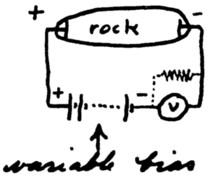
At 220 V bias, rock = <100 K ohms; Radiant = > 2 ma.(approximately)
Hence, it would appear that by increasing the bias to the highest practical value, the rock conductivity would be increased and, concurrently, permit a
more reliable measure of the intensity of the incoming radiation.
 Page 87
Page 87
In this circuitry, it would appear that the current readout would indicate the intensity of the incident flux.
High sensitivity indicating (or recording) instruments would not be needed. High input impedance would not be an important or limiting factor.
Using long-life "B" batteries of, say, 200 V, a portable sensor could easily be constructed, as:
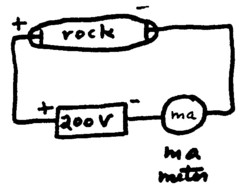
This, of course, assumes a linear relation between bias and conductivity. If the relation is not linear (or approx so), and resistance is reciprocal,
would the resistance reach minimum somewhere above 200-300 V?
 Page 88
208. The Gravitoelectric Generator.
Page 88
208. The Gravitoelectric Generator.
Honolulu, April 27, 1975.
In the previous section, it was foreseen (based on further confirmation) that very high voltages may be the key to obtaining direct conversion of
gravitic energy into usable electricity.
Unbiased rock electricity does not have (it seems) a practical and reliable electrical output. But with a bias of several kilovolts, it may have.
It would seem that rocks (and possibly other equivalent forms of dense dielectrics) will act as an electromotance when biased to the KV range. It is
interesting to note that no bias current would be required. Hence, no current is consumed in the excitation. The output of the electromotance represents the
net or usable gain. This gain, then, is the net conversion of gravitic energy into electrical energy. Its output is DC.
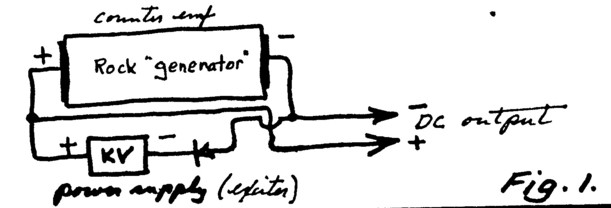
 Page 89
Page 89
Or, a clearer diagram may be:
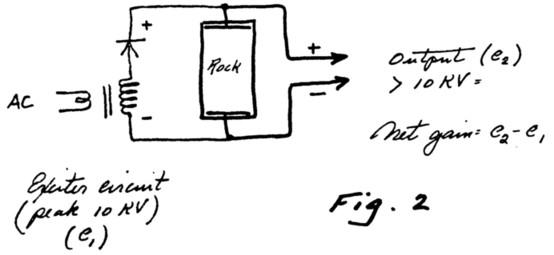
In the above circuit, as soon as the rock becomes fully biased (10 KV), it is generating a current in excess of the bias current. Minimum energy comes
from the exciter and the system becomes self-sustaining.
If excessive current is drawn, the output voltage may be drawn down to below 10 KV, at which time energy is again drawn from the exciter. Output
current, therefore, is limited to that value where the output voltage does not fall below 10 KV.
The output voltage of 10 KV is merely illustrative. Larger masses of heavy high-K dielectric (or rocks) and very much increased voltages may be used.
 Page 90
209. Bias-Assisted Sensors.
Page 90
209. Bias-Assisted Sensors.
Honolulu, May 1, 1975.
It now appears quite definite that the sensitivity of the rock sensors is increased by a bias voltage. Such a field (through the body of the rock)
provides polarization.
Based on the hypothesis that internal electric polarization facilitates charge-carrier separation (retarding recombination) of the
gravitoelectrically-produced pairs, it is reasonable to assume that the increase in conductivity will be a function of the polarization voltage.
In other words, increasing the applied bias increases the rock conductivity. It is quite possible that the amplitude of the diurnal or
secular variations will be increased as well.
A simple suggested circuit is:

The resistor provides a cushion so as to permit the variations in rock output to be observed, yet providing a steady polarization voltage to the
rock.
 Page 91
Page 91
Another more sensitive circuit, because it permits a balanced or null position, is:
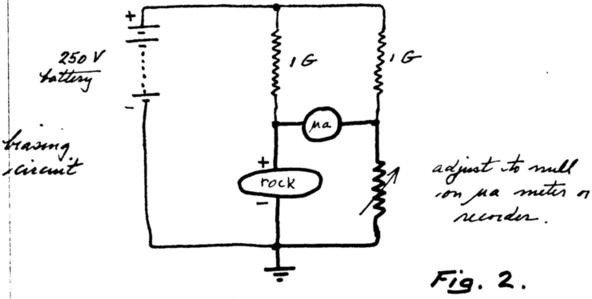
In this circuit, the output of the rock is balanced against the steady bias (to a very sensitive null position). Any slight change in the resistance of
the rock is readily observed and recorded.
Circuits as in Fig. 1 and 2 are being tested now and the results, so far at least, are quite encouraging.
Another example of bias-assistance in sensors is that of the resistance-diode-capacitance type, the so-called "synthetic" rock, as:

 Page 92
Page 92
In the circuit shown in Fig. 4, the applied bias opposes the polarity of the resistor diode emf, tending to balance the gravitically-generated emf. An
adjustable resistance, either in parallel or in series with the 1G resistor, provides for null adjustment. At null, this makes possible an extremely high
sensitivity for diurnal measurements.
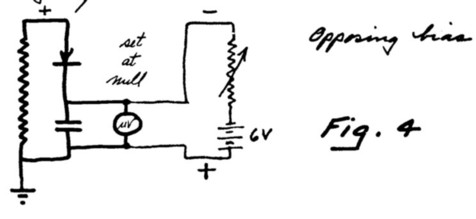
Using two matched rocks and 2 matched variable resistors seek null:
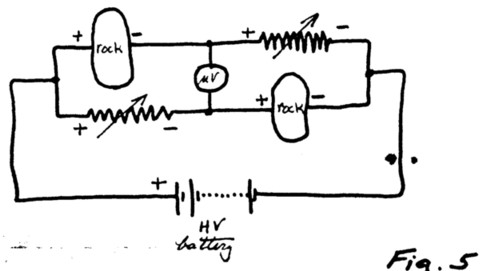
For detection of diurnal and secular variations.
 Page 93
Page 93
Simple series-bias circuit:
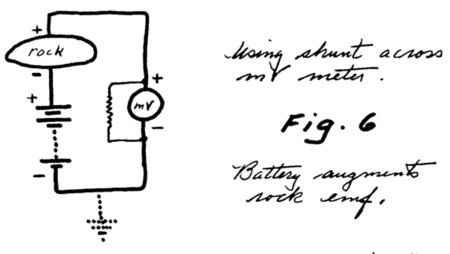 209-A. Retention of Bias by Resistors.
209-A. Retention of Bias by Resistors.
It is observed that battery-biased resistance materials (rocks and carbon spirals) tend to retain the bias. Similar to capacitors, the charge appears to
be retained for long periods of time. This is a phenomenon certainly far from being understood.

As in the above circuits, the polarization is retained by the resistor and/or rock for an unexpected and phenomenal length of time.
 Page 94
210. Piezoelectric Materials as Sensors.
Page 94
210. Piezoelectric Materials as Sensors.
Honolulu, May 9, 1975.
In Sec. 200 (p. 58), the use of piezoelectric sensors was discussed. Several units of this type have been tested over several weeks. Results are
quite encouraging.
The sensor is a piezoelectric tube (probably lead zirconate or equivalent). It is placed on a thermos flask for temperature stability and the flask is
covered with aluminum foil which is grounded. The coaxial lead to the recorder is also shielded and grounded.
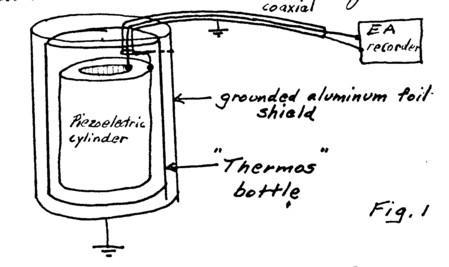
It is noted that the output, as indicated on the strip-chart recorder, shifts from positive to negative (polarity reversal) with a definite diurnal
cycle which does note correlate with room temperature. Placing the sensor in a thermos bottle increase its temperature time constant making it virtually
insensitive to rapid variations in temperature.
 Page 95
Page 95
It is sensitive, however, to sudden atmospheric pressure changes, showing sudden jumps with varying wind pressure. Long-term variations in pressure do
not show.
However, these are present long term variations which are diurnal. The interesting finding is that there is a fairly regular polarity reversal ( + to
- ) in the morning and an opposite reversal ( - to + ) in the afternoon. During midday, the readings are negative while during the night they are
positive. Please note, however, that opposite polarities (depending on recorder connections) are possible.
It is quite clear that polarity reversal take place (at this time of the year) about 8 AM and at about 6 PM.
In assembling the charts over the last 20 days, it begins to appear that there may be a sidereal drift of 4m/day. Assuming an Earth-shading effect, it
may mean that the source of this radiation is in the region approx 15h RA. Only by continuing these observations over a period of several months (better
1 year) can one be certain that this sidereal drift continues. If it does, it constitutes good evidence of a cosmic source.
 Page 96
211. Effects of Ambient Mass.
Page 96
211. Effects of Ambient Mass.
Honolulu, May 25, 1975.
In comparing the results of observations in the seismic vault (Hawaii Inst. of Geopysics) with those on the roof (10th floor) of my apartment building in
Waikiki, it is quite apparent that surroundings have an effect.
In the vault, 8 ft below the surface, the surrounding material is broken rock with dense (volcanic) material at floor level. In the penthouse at the
apartment, the walls are of concrete block with a concrete slab overhead. It is on the 10th floor with no nearby buildings.
Diurnal variations are pronounced at the penthouse whereas only long-term (secular) variations are observed in the vault. Diurnal variations are
minimal.
It would appear that ambient mass is responsible, acting very much like an electrical capacitance, to smooth out more rapid variations.
The mechanism is far from being understood. Speculating a bit:
(1) Ambient mass may re-radiate gravitic (cosmic) radiation on the same (or lower) spectral band. As such, it may be viewed as gravitic fluorescence.
 Page 97
Page 97
In such an event, the ambient mass may become excited in order to re-radiate, and this excitation may have persistence, therefore:
(a) a time lag would be introduced and a soothing effect.
(b) also, possibly energy absorption by the ambient mass, so as to reduce the sensor readings.
In general, this would mean that in order to observe maximum diurnal variations and all sudden changes, elevation (above earth) is important.
Locations in vary tall buildings are foreseen, especially where the surrounding walls of the instrument room are of light (non-metallic) material.
To insure against electrostatic gradients, copper screening is suggested. The ideal would be a thermally-insulated wooden shack with complete copper
screening, as high as possible above the earth.
It is true that such construction would no shield against magnetic fluctuations, but the sensitivity to such fluctuations can be determined by
deliberately introducing magnetic fields throughout the enclosure. The same applies to the penetrating em radiation, that which penetrates the copper
screening.
 Page 98
Page 98
Now that the equipment is being moved to SRI, perhaps some recording might be done at the top of some very high building in San Francisco.
Another interesting test would be to install recording equipment in a mobile lab which could be moved to various elevations and regions of various
ambient mass.
It is with this thought in mind that I would like to rent a camper this summer, install recording equipment and travel across the USA.
The necessary 115 V AC could be supplied by a converter from 12V storage batteries which could be recharged periodically.
Perhaps such a trip could start from Palo Alto, using the recorders now being shipped to SRI. Installation could take place at Polytec Prod. Co. at
Menlo Park.
If funds become available, July 10 would be a good starting date.
 Page 99
212. Pulse-Polarization of Sensors.
Page 99
212. Pulse-Polarization of Sensors.
Honolulu, May 25, 1975.
In the previous sections, the polarization of rock sensors by applying DC was discussed. Rocks could be polarized by heating to a temperature above the
Curie Point, then applying a high voltage field as the rock cools through the Curie Point. We might call such electrified rocks geoelectrets. See Sec. 172,
p. 137, Notebk 3.
If we are ever to extract usable energy from rocks, several factors must be considered:
(1) The rocks must be strongly polarized.
(2) If polarization voltage is supplied, the natural electrical resistance of the rock consumes energy, converting it into heat (Joule heating) and then
lost.
(3) It is probable that the polarization energy may exceed the converted (gravitoelectric) energy, i.e., no net gain.
If, however, adequate polarization can be maintained by frequent short duration pulses, the situation may be corrected. It is proposed, therefore,
that high voltage pulses (say, 1 millisecond) be substituted for DC excitation, with the pulse frequency being determined as needed to maintain a
fixed polarization. Gravitoelectric energy may then dominate the output.
 Page 100
Page 100
The circuit may be as follows (Figures 1 / 2) ---
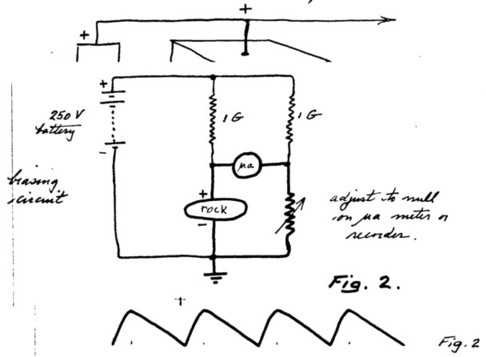
Or, a switching arrangement may be provided to disconnect the load during the instant of pulse.
It is assumed that output voltage would decay after each pulse, as Fig. 2.
But the energy differential would favor the output because of the slow decay, being fed by gravitic conversion.
 Page 101
213. Possible Correlation with Dow-Jones Industrials.
Page 101
213. Possible Correlation with Dow-Jones Industrials.
Avalon, CA; July 23, 1975.
For many years, I have felt that a correlation may be found between sidereal radiation and the stock market. Even as early as 1937 such a
correlation seemed to exist. Then, through the years, no positive follow-up occurred and the effort was abandoned.
Now, realizing that the incoming radiation covers a broad spectrum, ranging from a few Hz to MHz and higher, individual sensors only cover relatively
narrow bands. Diurnal phasing and secular variations of the various sensors are all different. The idea of a general correlation becomes lost in the
welter of differences.
However, by accident, a certain rock (Catalina Granite) has been connected to a Triplett meter Model 8035 Type 1 for several months. Readout has been
charted, and a phenomenal correlation with the DJ Averages appears to persist. It is being watched with great interest.
There appears to be a lag (radiation to DJ) of about 4 days. In the earlier correlation (1937 and 1939), the lag appeared to be about 2 days.
No explanation seems to exist.
 Page 102
Page 102
Charting was started May 31, 1975 and is continuing (July 23). Five reversal of trend have, so far, taken place. The probability of this is
astronomical.
Continual charting is necessary before we can be sure, but if a correlation (with a 4-day lag) is, in fact, confirmed, the financial possibilities are
staggering.
In anticipation of such possibilities, I have prepared a prospectus of an experimental market account to be known as the magnum Fund. Such a fund would
operate under the aegis of the Townsend Brown Foundation. Participation might be offered to interested scientists or other knowledgeable person purely as a
venture experiment.
If successful, profits would be routed into scientific research. The office of the fund would be in Sunnyvale, CA with Dean Witter and Co (Palo Alto) as
the broker.
Operation is scheduled to begin about August 1, 1975.
 Page 103
214. Self-Potential in Calcareous Solids.
Page 103
214. Self-Potential in Calcareous Solids.
Avalon, July 23, 1975.
The phenomenon of self-potential in rocks was first observed in Catalina granite. For some time it was believed that it could be observed only in
silicaceous materials, but in Hawaii it was also found in beach sand, primarily calcareous.
Now, I am wondering if calcareous solids such as bone (human bone) might also give rise to self-potentials. It would be interesting to try fresh animal
bone such as beef), dried bone and even ancient bone to see if an emf is present, and (even more significant) if such potential varies in a diurnal or
secular pattern.
If so, one may speculate on the possibility that, in living bone, the bone marrow is affected by the electric field, possibly altering the generation of
red blood cells or the many other complex biochemical functions living bone serves in the body.
This may be a clue as to the mechanisms by which sidereal radiation may affect man’s mental or physical well-being, hence, his mood relative to
investments.
 Page 104
215. Self-Maintained Polarization.
Page 104
215. Self-Maintained Polarization.
Sunnyvale, CA; Oct. 5, 1975.
The beneficial effects of polarization have been repeatedly observed. There is no doubt that, by initially applying a high voltage to a rock sensor, a
higher reading (output) is obtained. The rock acts like a storage battery, retaining a charge for long periods of time. But unlike a capacitor, the
charge cannot be instantly shorted. It tends to return to its former value.
However, over long periods of time, the charge gradually diminishes and some rocks "go dead". It is obvious that the rocks have simply become
depolarized. Such rocks may be reactivated or repolarized by subjecting them to a high voltage, especially when the potential is maintained or several
days.
Since it is believed the incoming radiation (possibly gravitational radiation) produces RF in the body of the rock, a method is herein suggested
to maintain polarization.
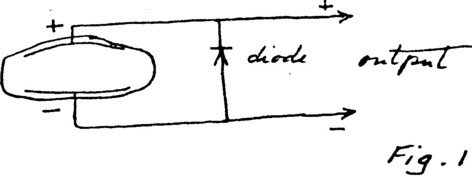
 Page 105
Page 105
The use of a diode to rectify the RF supplies a DC polarization voltage. The diode passes pulses only in one direction and will continue to charge the
rock so long as the rock output (DC) potential does not exceed the peak inverse of the diode.
Units of this type may be placed in series to produce and maintain higher output potentials. This may be the answer to a commercially useful power
source, as:
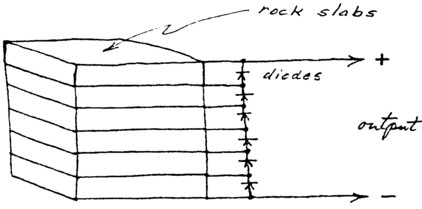
Before connecting the diodes, the rock slabs should be individually polarized (or if a high voltage --- RF --- is used, the entire series may be
polarized at once). The diodes are connected only after the voltage has fallen to a value below the peak inverse of the diodes.
Such a circuit may prevent depolarization.
 Page 106
216. Bleeder-Sustained Polarization.
Page 106
216. Bleeder-Sustained Polarization.
Sunnyvale, Jan. 2, 1976.
In the foregoing sections, various methods have been proposed to maintain polarization in rocks. In Sec. 209, a simple circuit is described to accomplish this.
This circuit now appears to deserve further consideration and testing.
The Koolau Plug rock normally has a self-potential at room temperature of about 400 mV. Using a bleeder-type charging circuit to balance the load of the
readout, this self-potential is greatly increased:
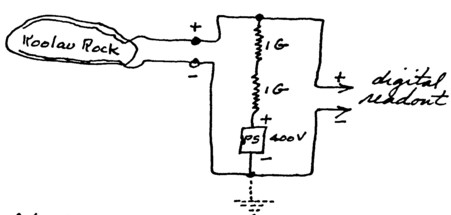
Starting today, this circuit, using 400 V power supply and 2G resistors, is being tested for diurnal fluctuations.
Observed variations are as follows:
 Page 107
Page 107
[Page 107 is blank]
 Page 108
217. Self-Potential in Ceramic Capacitors.
Page 108
217. Self-Potential in Ceramic Capacitors.
Sunnyvale, Jan. 16, 1976.
Polarized piezoelectric ceramic cylinders were tested in Hawaii, See Sec. 200 and 210. The characteristic of retained polarization appeared to make them
effective sensors. This work should be continued.
Now, it appears that ordinary high-K ceramic capacitors are good sensors for diurnal variation and glitches. The so-called "cartwheels" --- 2000 uufd
are examples. Even without polarization, the observed diurnal fluctuations are striking.
In tests now underway, five cartwheels are connected in parallel. Vestigial self-potential is present to a few millivolts. These capacitors are aligned,
when connected together, so that the self-potential or remnant polarizations are in the same direction. Squeezing the individual capacitors with the
fingers produces a voltage shift of all five units in the same direction. This, of course, is a piezoelectric effect shared by most ceramic capacitors.
The capacitors are then connected in parallel, enclosed in a plastic (insulating) bag which is then wrapped in aluminum foil which is grounded.
 Page 109
Page 109
The assembly is placed in the constant temperature (90 F) box and connected directly to a millivolt recorder.
Rapid variations are observed, so that it is helpful to connect a 2 ufd polycarbonate capacitor to smooth the output.
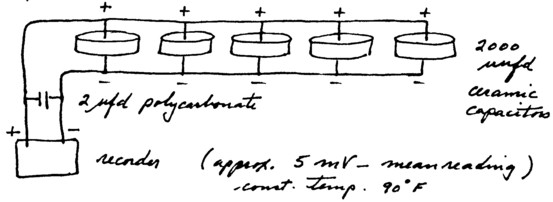
Three glitches have appeared to date (2 neg and 1 pos) which instantly carried the recorder pen to the chart limit. Recovery to the original reading
took place within a few minutes.
The rapid fluctuations (extreme sensitivity) is a feature of this system. Diurnal cycles, even at constant temperature, are clearly evident. Atmospheric
(barometric) pressure does not seem to be responsible or even to affect the voltage output. Vibration, within the limits of observation during the tests,
likewise appears to have no effect.
 Page 110
218. Heavy Metal Oxides as Sensing Media.
Page 110
218. Heavy Metal Oxides as Sensing Media.
Sunnyvale, CA; April 22, 1976.
From the very beginning of this gravitational research (Janesville, 1926), lead monoxide (litharge) has been used as a high-K dielectric material. The
advantage stems from is high density (mass as well as its high dielectric constant (K).
Early gravitators were made of litharge bound in paraffin or beeswax.
More recently, litharge-glycerine mixtures have been used. This is not actually a mixture but a chemical compound, inasmuch as a chemical reaction
takes place following mixing. This reaction is exothermic, resulting in a rock-hard mass which is quite heavy and, after drying, is a good (high-K)
dielectric.
Sensors made of this material appear to develop self-potential with higher current capabilities. Internal resistance is lower, so that generated power
(wattage) is higher. This material makes excellent gravitic sensors --- not particularly piezoelectric and only slightly pyroelectric.
Hence, the direction this research seems to be taking is toward the more massive metal oxides and carbides as dielectric materials.
 Page 111
Page 111
One of the most promising appears to be tungsten carbide (WC).
Tungsten carbide powder or granules bound in Carnauba wax is suggested. Tests are being planned.
The electret ability of Carnauba wax is well known. It is the classic electret material, capable of generating (more accurately, retaining) quite
high voltage, even in the K range when properly polarized. But the resistance of Carnauba wax is so high that only microamperes can be withdrawn. The output
energy is entirely related to and dependent upon the (input) polarization energy.
The thought now is that by loading Carnauba wax with tungsten carbide powder, the resulting massive electret would gain energy from gravitic
radiation, acting as a converter as well as a storage device.
Tungsten carbide has a very high density (specific gravity) almost that of gold. The carbide has a fairly high electrical resistance, so that it may make
an ideal material for gravitic sensors. Tests of this material are being planned at the present time at UC Berkeley.
 Page 112
219. Construction of the Tungsten Carbide Sensor.
Page 112
219. Construction of the Tungsten Carbide Sensor.
Sunnyvale, April 23, 1976.
In the foregoing section, tungsten carbide was suggested as a suitable high-output gravitic sensor. The high density of tungsten and the carbide make
it particularly desirable as a gravitic radiation receptor. The carbide powder is mixed in a suitable liquid binder such as Carnauba wax (molten) and
polarized during cooling and solidification.
To reduce thermal effects (pyroelectricity), casting may be done in Dewar flasks. High voltage DC is applied during cooling to polarize the sensor.
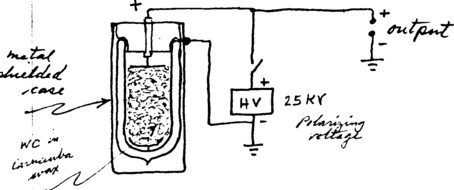
It is believed that the use of WC will provide relatively high self-potential. If allowed to cool and settle slowly, compacting the WC
particles, a lower internal resistance will result. This will produce a higher power output (watts).
 Page 113
220. Glycerin-Litharge Sensors.
Page 113
220. Glycerin-Litharge Sensors.
Sunnyvale; May 6, 1976.
In Sec. 218, the rock-hard mixture of glycerin and litharge (PbO) was discussed. A small shielded sensor (aluminum box 2 x 4 x 6) has been tested
and found to be one of the best sensors made to date.
Tests at the UC Berkeley indicate that its power peak is somewhere near 100,000 ohms. Continuous voltage output of approx 5 mV was obtained with a
10,000 ohm resistance load. The output undergoes a surprisingly smooth diurnal cycle of approx 20 mV with the Houston recorder as the only load (100
megaohm).
Strangely, this sensor reversed polarity when it was moved from Berkeley to Sunnyvale. At the moment, it is operating in my apartment in Sunnyvale,
ranging from –2 to –20 mV.
Originally, it was polarized (positive) with 300 V DC, while it was hardening. At Berkeley, it indicated approx +50 mV. The reason for reversal of
polarity is not known. It is potted in paraffin so there should be minimum moisture (humidity) effect. Also very low, if any, piezoelectric and
pyroelectric effect.
 Page 114
221. The Strong Glitch of May 4, 1976.
Page 114
221. The Strong Glitch of May 4, 1976.
Sunnyvale, May 6, 1976.
This glitch or event was recorded on both the barium titanate and Catalina granite in the mineshaft at UC Berkeley. It has a sudden commencement at 0300
PST (110 GMT) on Tuesday, May 4. Catalina granite went off-scale at 97 mV; its peak could not be traced. Barium titanate peaked 28 minutes later (20% rise)
--- voltage gain from 6.96 to 8.35 mV, then fell to a minimum at 0350, a total duration of approx 50 minutes.
It is to be pointed out that this event occurred in the mineshaft early in the morning. No person was present. Power failure (or surge) was ruled out by
investigation by Jim Jardine, who deliberately produced failure the following morning with no similar effect. Instrumental trouble also was ruled out. The
glitch appears genuine.
It is noted that this event occurred at approx 17h sidereal time, at approximately upper meridian transit of the galactic center. This may or may not be a
coincidence. In any event, it is a strong (pulse) increase in energy recorded in two different dielectrics.
 Page 115
Page 115
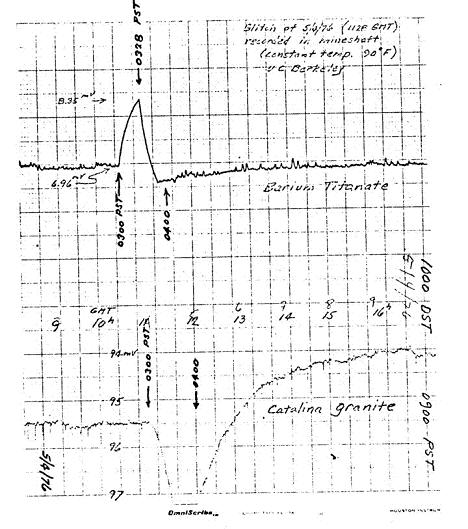
 Page 116
222. Electrolytic Capacitors as Sensors.
Page 116
222. Electrolytic Capacitors as Sensors.
Sunnyvale, May 10, 1976
Because of their high capacitance-to-volume ratio, electrolytic capacitors are generally used in compact circuitry. Because of their electrolytic
(electrochemical) construction, they usually generate a small emf. This emf is often temperature related.
However, it now turns out that these compact capacitors may also be gravito-voltaic. Test with Mallory 18,000 ufd reveal a surprising diurnal
variation at constant temperature. Voltage ranges from –0.5 to –1.5 mV during recordings today. It is noted that the polarity of the self-potential is
reversed fro that indicated as the working polarity of the capacitor. Phase is also reversed, with maximum occurring at approx 10 AM and minimum late at
night.
Jim Jardine reports that a [blank] ufd electrolytic (at UC Berkeley) shows a pronounced diurnal (and other) variations which surprised him.
I plan to put the Mallory 18,000 ufd in the constant temperature box in the mine. Results will be reported.
 Page 116
223. High Flux Density in the Great Pyramid.
Page 116
223. High Flux Density in the Great Pyramid.
It is fascinating to speculate on the reasons for building the pyramids of Egypt and, for that matter, the massive stone monuments of the Yucatan
Peninsula and elsewhere.
Thoughts have been expressed that some form of energy may be concentrated by the peculiar (pyramid) shape. Is it possible that this may be true?
Measurement of self-potential in the mineshaft at Berkeley indicate a greater flux density than outside. If this flux is gravitic radiation
(possibly in the optical frequency range), perhaps the same king of increase may be present within the pyramids. Reradiation of the incident primary (from
space) by a rock mass may be termed gravitic fluorescence (see Sec. 211). The reradiated energy may have different spectral characteristics from the
primary.
Gravitic fluorescence, it is conceived, would be homologous to optical fluorescence. For example, minerals fluoresce under UV light. The color is
characteristic if the mineral, not of the incident UV. The re-emission of energy is at a lower frequency.
 Page 117
Page 117
In the case of gravitic fluorescence of granite, the primary radiation from space may have optical frequency, even quasi-UV, and the re-emission may be
gravitic in the Angstrom range or lower. As such, it would be invisible and non-detectable as an em radiation.
In other words, if the granite of the great pyramid serves to intercept and re-emit primary gravitic radiation from space, the flux density at the center
of the pyramid would be greater than outside. There may be, in effect, a focusing of the flux toward the pyramid center.
If this is so, the King’s Chamber would be located near this focus. Did the architects of Cheops understand this? Could this knowledge have come from a
more advanced technology of some extraterrestrial culture?
Is this increased flux density observable today? Would granite sensors, such as those we have in operation at UC Berkeley (in the mineshaft) reveal a
higher self-potential?
Another point upon which we might speculate is the strange and unusual structure of the King’s chamber and its overhead or roof. Why is there a
series of granite rocks, with space between, above the King’s Chamber?
 Page 118
Page 118
This strange structure is as follows:
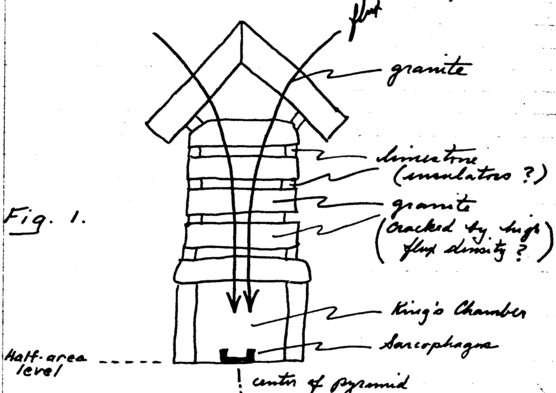
Could this configuration amplify the gravitic flux produced by the body of rock forming the rest of the pyramid? Are the limestone blocks insulators? Is
this overhead arrangement of granite blocks for the purpose of increasing the flux density in the King’s Chamber below?
In the lab, could we use this arrangement of granite slabs (spaced and insulated from each other) to intensify gravitic flux density? Would this
produce a higher self-potential in the bottom rock?
 Page 119
224. Biological Effects of Secondary Radiation.
Page 119
224. Biological Effects of Secondary Radiation.
Sunnyvale, June 7, 1976.
If future experiments to confirm the existence of gravitic fluorescence (secondary radiation) from rocks, does this radiation have biological effects?
It is hard to conceive that Nature has failed to utilize this form of energy in one way or another. The fact that our human eyes do not perceive it
does not mitigate against its presence all around us. Do birds or fish perceive it? Is the homing instinct related to such possible perception? Were
the ancients aware of its existence and/or influence?
In the foregoing section, the thought was advanced that the pyramids (and other prehistoric stone structures) might be receptors and concentrators of
gravitic flux. Were the architects aware of the possible effects even though they may not have known the reasons?
Was the geometrical shape of the pyramids convenient as a burial mausoleum for kings or was the shape chosen for other (perhaps advanced) esoteric
reasons? Did a more advanced culture (perhaps extraterrestrial) dictate the pyramid shape to accomplish some result?
 Page 120
Page 120
Was this shape purposely selected and utilized to aid the king in the afterlife? If so, would the increased flux density esoterically assist toward
this end?
It is rather amazing to see that the sarcophagus (believed to have held the king’s body at one time) is located exactly at the center of the pyramid
(Cheops) and at a location which could be the focus of secondary radiation.
It has been reported that mummification is accelerated in the pyramid and that organic bodies do not decay. Could this radiation be responsible? If so,
does such radiation assist organic processes or suppress them? Is such intense flux life-giving or death oriented?
What of the many explorers who have penetrated the pyramids in the past? Men who have spent long periods, cutting into corridors, mapping and studying?
Was their health or longevity affected? I should like to conduct some research on the subject.
In any event, it would be worthwhile to study the possibility that secondary radiation may have profound effects on biological processes,
beneficial or detrimental. Could stone or concrete buildings, for example, prove to be hazardous to health and well-being --- perhaps even carcinogenic?
 Page 121
Page 121
In this age of concrete buildings, are we overlooking one of the reasons for increased incidence of cancer?
Some measurements of gravitic flux density must be made. A portable sensor, similar to a Geiger counter, would be very helpful. As a geophysical survey
tool, a gravitic flux meter may be used to map subsurface domains of granite or geothermal reservoirs, even perhaps deposits of minerals or oil. It is with
this end in view that I am hoping to fit out a mobile laboratory or survey vehicle (camper) to conduct profile studies.
Such studies may provide isometric maps of natural flux density across various California (and other) regions which may be extremely valuable. No
other survey tool, available today, could provide such information.
A flux meter of this type could be used in the determination of pyramid radiation, if such radiation does, in fact, exist.
A group from SRI pans to make a trip to Egypt this summer in connection with other studies. It is our hope that they will be able to take a gravitic
flux meter with them, specifically to use in the Cheops pyramid.
 Page 122
225. Gravitic Radiation Receptor Materials and Binders.
Page 122
225. Gravitic Radiation Receptor Materials and Binders.
Sunnyvale, June 9, 1976.
Receptors: In looking for possible receptor materials, the principal characteristics would seem to be mass and high dielectric constant. Conducting
metals are excluded because of usual inability to obtain voltage gradients in thicker sections. In thin sections (filiform) there is a chance that usable
self-potential can be obtained. Long thin wire sensors will be discussed in the next section (226).
In general, high-mass sensors must be of high-resistance materials. Lead monoxide (PbO) was the first of such materials to be tested. It is heavy and
has a high electrical resistance.
Barium titanate and lead zirconate-titanate are similarly effective. Both have been used in sensors made to date.
Tungsten carbide is a new contender for the honors and promises to be even more effective (See Sec. 219).
These heavy powders may be bonded by compression, sintering, or by the use of a binder. Initial polarization is not normally possible during compression
or sintering, although in the future some technique may be worked out.
 Page 123
Binders
Page 123
Binders: Several liquid binders are possible which can permit polarization during hardening. Among them are the waxes, such as paraffin,
beeswax and Carnauba wax. Polarization is accomplished by applying a high-voltage field as the binder hardens upon cooling.
Other binders such as polyurethane and methyl acrylate harden by the use of an accelerator. There are many plastics of this nature which may be used to
bind the receptor materials.
Another interesting possibility is ordinary Portland cement. When mixed with water it is electrically conducting, but its resistance increases as it
sets. Concrete blocks may prove to be effective sources of gravitic self-potential. If the aggregate is crushed granite, monazite sand or even
such receptor material as tungsten carbide, the use of Portland cement (or the like) may be quite effective.
It must be borne in mind that the internal resistance of a gravitic battery must be low if high currents are required. If only high voltage is required,
the internal resistance may be high. Peak power output from any receptor material depends upon matching the internal resistance with the load.
 Page 124
226. Long-Wire Sources of Self-Potential.
Page 124
226. Long-Wire Sources of Self-Potential.
Sunnyvale, June 9, 1976.
The generation of white RF noise in long wires was discussed in Sec. 140 and 180. This RF is rectified by a diode and stored in a capacitor (as DC). If
the molecules of the metal forming the wire are polarized aligned) by a strong current while the metal is cooling from a high temperature, the long wire
becomes polarized so as to produce a DC self-potential.
Thus, the metal of the wire becomes a gravitic receptor.
Tungsten, due to its high mass (sp. gr. 18) in fine wire form appears to be ideal.
A tungsten wire sensor would then be a non-inductive resistor of very fine wire which has been cooled from a high temperature while carrying a current.
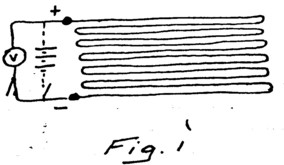
Tungsten wire non-inductive grid heated then polarized while cooling.
 Page 125
227. Concrete Blocks as Gravitoelectric Converters
Page 125
227. Concrete Blocks as Gravitoelectric Converters
Sunnyvale, June 9, 1976.
In Sec. 225, the use of Portland cement as a binder was discussed. This idea may have some real practical value in constructing converters for power
generation. Batteries would be large and relatively inexpensive.
Using concrete slabs with suitable crushed granitic or basaltic aggregate, electrically polarized upon curing, self-potential may be developed which
would be additive by connecting the slabs in series.
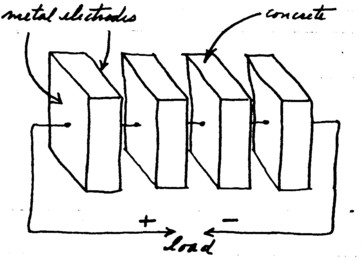
Concrete blocks electrically polarized while curing. Connected in series to produce DC output.
The relatively low resistance of the Portland cement (binder) may provide a high current output.
 Page 126
228. Self-Potential in Long Wire Resistors.
Page 126
228. Self-Potential in Long Wire Resistors.
Sunnyvale, June 11, 1976.
In Sec. 226, the idea of long-wire sources of self-potential was set forth. The thought was developed that long wires of massive materials (such as
tungsten) being cooled while conducting a current, would retain a polarization which would result in a continuing self-potential.
If this is so, long-wire resistors may be made gravitovoltaic by subjecting them to a high initial voltage, then lowering the voltage slowly as the
resistor cools. The high initial voltage and current aligns the constituent molecular dipoles which remain aligned as the current drops and temperature is
lowered past the Curie temperature.
Hence, resistive materials in general, if heated by excessive DC current above the Curie point, then allowed to cool, would thereafter become a source
of self-potential. In other words, an overloaded resistor may become a battery. This would, indeed, be a surprising discovery if valid.

 Page 127
Page 127
One wonders why this effect has not been noticed before. High voltage resistors have been operated at high currents with seemingly constant
characteristics, or have they? If anomalies have been noted, perhaps they have been attributed to errors in observation.
Assuming that long-wire resistors can be polarized by DC overloading so that they will (thereafter) produce a voltage, the problem of creating a
useful battery may be solved. The internal resistance may be selected to match the load and hence provide peak power output.
Various metals, not necessarily tungsten, may have differing characteristics, as to Curie temperature, retention of polarization, and
resultant self-potential. Tungsten was originally suggested because of its high density, but aluminum, iron, copper, nichrome and many other metals,
alloys or even ductile ceramets may prove to be better.
After all, there is very little basic difference between resistive materials in so far as the ability to generate self-potential is concerned. Mass (density) is important.
Experiments to check the above should be conducted as soon as possible.
 Page 128
229. Tungsten Carbide Gravitovoltaic Converter.
Page 128
229. Tungsten Carbide Gravitovoltaic Converter.
Sunnyvale, June 13, 1976.
In Sec. 219, tungsten carbide (WC) was proposed as a probable effective material for a battery. Much depends upon its electrical resistance. This will
have to be researched. The high mass of tungsten compounds appears to make them ideal as gravitic receptors.
Tungsten carbide (WC), bitungsten carbide (W2C), thorium tungsten and the like may be compressed (as powders) into a heavy semi-conducting mass. Better
still, if high temperature casting is possible, or if the material is sintered, the resultant mass may make an effective battery.
Such a mass would be heated above the electrical Curie temperature and then, in the presence of a high electric field, oil-quenched (or otherwise
cooled) to retain electric polarization.
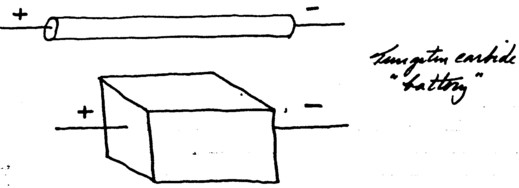
 Page 129
Page 129
[Missing]
 Page 130
Page 130
Also present is a vertical anisotropy, wherein the maximum voltage always appears when the front end is up, i.e., toward the zenith. In most
observations, voltage at zenith is double the voltage at nadir. This appears to have no relation to the proximity or direction of an electric line.
When the sensor (resistor, diode, capacitor combination) is horizontal, the azimuth effects are observable with greatest voltage when the front (end) is
directed toward the south (presumably the magnetic south). When in this position, voltage is further increased when the south end is raised
(presumably to the point (angle) where the sensor is aligned with the magnetic declination).
To be convincing, this experiment must be repeated out in the open, away from power lines, etc., which now confuse the results. Shielding studies
should also be carried on, although shielding may cancel out the basic effect in which we are interested.
If this phenomenon is indicative of an ether flow (from the south --- ref. Miller interferometer observations), a metallic casing may "kill" the effect.
It is best, for the moment, to utilize the Plexiglass casing alone.
 Page 131
231. Spontaneous Heating of Petroelectric Materials.
Page 131
231. Spontaneous Heating of Petroelectric Materials.
Sunnyvale, Oct. 1, 1976.
Where an emf is generated (as in any kind of electromotance, such as a battery), and the external circuit has low resistance, the internal resistance
(of the battery) causes heating through Joule "heating".
In other words, if a battery is shorted, it will get hot.
This Joule heating will undoubtedly be present if a petroelectric source is shorted. An active petroelectric sensor should become warmer than its ambient
if it is electrically shorted.
The energy of the evolved heat may be converted from optical frequency gravitational radiation. Increased petroelectric voltage would cause increased
heating. Therefore, the temperature would necessarily correlate with the diurnal or secular variations in the gravitic input.
If this is true, certain rocks or other gravitovoltaic materials (if shorted) will be warmer than their environment.
 Page 132
Page 132
This presents some interesting possibilities. For example, a large rock (in nature) may be petroelectrically active, but will not be warmer than the
environment until it is electrically shorted. If, however, it is finely ground and the sand-like particles are mixed, and if the particles themselves are
petroelectrically active, it follows that shorting per se results from the interacting of the particles.
Conclusion:
(1) Finely ground petroelectric material (especially when compressed) may be found to be warmer than the environment. This spontaneous evolution of heat
may show the same diurnal and secular variations as the unground pieces which are electrically shorted.
(2) The spontaneous evolution of heat of certain complex silicates, lavas and clays (ref, Charles F. Brush) may be due to gravitoelectric conversion.
(3) Such heating would be directly related to the energy (at that frequency) of the incident optical-frequency gravitic radiation.
This phenomenon appears to be the same as that discovered by C.F. Brush in Sandusky clay and related materials. Calorimetric tests were performed by
Harrington, National Bureau of Standards.
 Page 133
232. Commercial Possibilities of Petroelectric Heating.
Page 133
232. Commercial Possibilities of Petroelectric Heating.
Sunnyvale, Oct 2, 1976.
If the phenomenon discussed in the previous section actually exists, as present evidence seems to indicate, the practical applications of such a
source of heat are virtually unlimited.
Assuming, of course, that materials may be beneficiated so as to increase their petroelectric activity, finely ground particles of such materials,
especially of compressed, may provide:
(1) A direct gravito-to-thermal output;
(2) Spontaneous and continuous heating of materials such as:
(a) Gypsum-compound wallboard for cold climates;
(b) Blankets and certain clothing;
(c) Engine warmers;
(d) Heating devices, low-temp. furnaces;
(e) As a constituent in concrete;
(f) Snow-melting pavement;
(g) No-fog mirrors, etc.,
and various other applications too numerous to mention!
 Page 134
233. Lawson Adit Petrovoltaic Readings
Page 134
233. Lawson Adit Petrovoltaic Readings

The above readings appear to be typical of petroelectric voltages observed in the Lawson Adit (UC Berkeley) during mid-summer of 1976.
Catalina granite undergoes a diurnal variation, approx 5 mV amplitude, peaking about noon with minimum near midnight.
Barium titanate also shows a diurnal effect primarily in the amplitude of micro-pulsations.
Recording by Jim Jardine, UC Berkeley.
 Page 135
Page 135
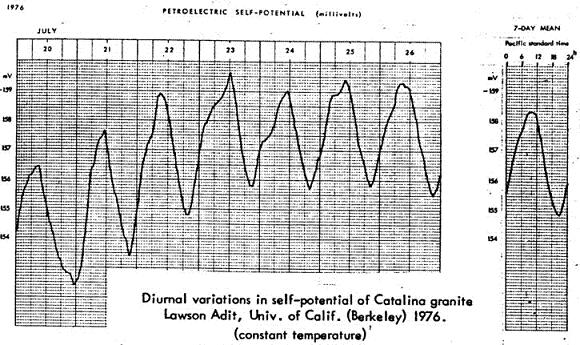
The above readings of Catalina granite were made in the Berkeley mineshaft approx 250 ft back from the entrance and under an estimated 200 ft of rock
overburden. Sensors were located in a constant temperature chamber (90 F +/- 4 F) and at a relatively constant humidity. Sensors were electrostatically
shielded with grounded shields.
It is noted that both a diurnal cycle and a secular change (gradual rise) was observed.
Recording was unattended. Mineshaft was entered only at the beginning and end of the run. Serviced by Jim Jardine.
 Page 136
234. K-Waves in Space.
Page 136
234. K-Waves in Space.
Sunnyvale, Nov 18, 1976.
For some time, I have toyed with the idea that the electric permitivity of space, as well a the magnetic permeability, is not constant but varies from
place to place, as, for example, in regions of great gravitational potential. Ref. Sec. 109 (1973).
Further, it would appear that variations with time may appear, as, for example, with the passage of a gravitational wave.
Hence, a K-wave may be indistinguishable from a gravitational wave, one being concurrent with the other. The gravitational wave would be difficult to
detect, but the K-wave may be relatively easy to detect.
Reviewing the proposal set forth in Sec. 108, Rec. Bk. 2, a capacitance bridge should be considered.
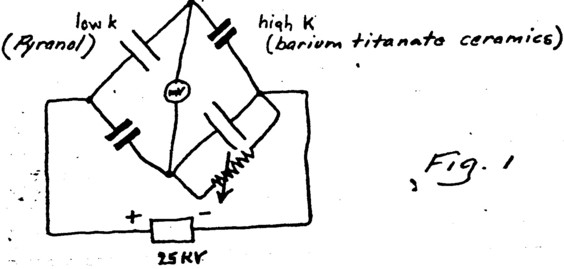
 Page 137
Page 137
If the K of the ambient space varies, the low-K Pyranol would be (percentagewise) affected more than the high-K ceramics. Hence, a differential
situation would exist. The indicating high resistance multivoltmeter would reveal the differential.
Both types of capacitors will have resistance (leakage) and, therefore, to balance at null, a zero-adjusting resistor must be used (as shown in red).
Petroelectric sources may likewise be used, either with rocks for both legs of the bridge or rocks and capacitors used in balance, as:
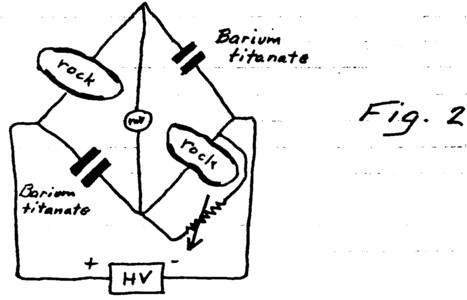
Such systems must be operated in constant-temperature, magnetically- and electrostatically-shielded boxes.
 Page 138
235. Glitch-Detecting Circuit.
Page 138
235. Glitch-Detecting Circuit.
Sunnyvale, Nov 22, 1976.
The relatively large amplitude of the secular and diurnal variations make it difficult to set alarm limits (contacts) for glitch warning signals. A
continually moving base, acting as a running average, is needed. A sudden glitch, above or below such a base, may trigger pre-set alarm limits, serving
as a warning of an oncoming glitch.
Such a circuit is as follows:

Petroelectric emf is stored in the large capacitor, so that only sudden changes in emf actuate the alarm contacts.
The resistor diode sensor may be connected in the same way.
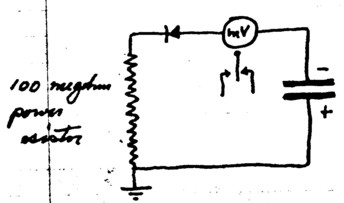
 Page 139
236. Electrolytic Capacitors as Sensors (Part 2).
Page 139
236. Electrolytic Capacitors as Sensors (Part 2).
In the various tests using electrolytic capacitors as storage means, the question has arisen as to the capacitor stability. Do such capacitors develop
self-potential similar to rocks? Is such self-potential (if it exists) due to an electrochemical or gravitic source? Does it partake in diurnal fluctuations
which are not related to changes in temperature? If it is purely galvanic in nature, continuous readings at constant temperature will reveal the answer.
Ref. Sec. 222.
According, preliminary tests are as follows:

Readings at room temp. --- variable.
 Page 140
237. Battery-Referenced Electrolytic Sensors.
Page 140
237. Battery-Referenced Electrolytic Sensors.
Dec. 16, 1976.
In the foregoing section, consideration was given to the spontaneous emf produced by electrolytic capacitors. Using high-capacitance units, such as
Mallory 3V, 115,000 ufd, with a standard cell 3V bucking circuit, measurements are proposed for detection of charging-discharging rate, as:

The capacitor is initially charged to 3V by closing switch, allowing sufficient time to become thoroughly saturated. Then the switch is opened.
The conductivity of the mV meter is such as to (normally) keep the capacitor fully charged (polarized). Any variation in the self-potential of
the capacitor (above below 3V) will be indicated as a plus or minus voltage by the meter. All this assumes, of course, that the standard cell voltage remains
constant. This test should be conducted at constant temperature.
 Page 141
238. Electrolytic Sensors (continued)
Page 141
238. Electrolytic Sensors (continued)
Jan. 16, 1976.
In the two previous sections, the use of electrolytic capacitors (of extremely high capacitance) was considered. Tests have now been run for the
last several days with rather surprising results.
Using the Mallory 115,000 ufd 3V DC with a single dry cell and the HP digital readout, as:
 Results
Results: Battery constant at 1.542 V, the capacitor stabilized at approx 1.080 V, the readout represented the difference 0.462 V. But the
readout underwent systematic variations not entirely due to temperature changes. Variations occurred while room temperature remained constant.
Furthermore, a strong glitch occurred between 0600 and 0610 (temp. steady at 66 F) today of magnitude 26 mV.
It is to be understood that during this glitch the capacitor emf fell 26 mV and then returned to its former value within 10 minutes. No external factors
were observed which could have accounted for the sudden voltage drop.
 Page 142
Page 142
In an attempt to understand the significance of this negative glitch, the following thoughts come to mind.
(1) It must be recognized that the energy storage in a 115,000 ufd capacitor is relatively great. Over short periods of time, such as 10 minutes,
high stability would be expected. What could cause momentary loss of voltage with subsequent complete recovery?
(2) If the stored energy remained constant, voltage change could (I believe) result from a momentary change in the dielectric constant (K) of the
dielectric material of the capacitor. A sudden increase in K would cause a proportionate decrease in V.
(3) A similar result might come from a sudden increase in the conductivity of the dielectric.
Hence, the voltage dip may be caused by (1) an increase in K, or (2) an increase in conductivity (decrease of resistance).
Ionizing radiation, such as a cosmic ray shower or gamma ray burst from space could, I suppose, produce a sudden increase in conductivity. If so, the
use of electrolytic capacitors as sensors for such penetrating radiation would be worth investigating. To my knowledge, no such evidence exists today.
 Page 143
Page 143
One must consider the observed fact that the voltage returned to its former value after the glitch. If the momentary effect resulted from an increase in
conductivity, would there not be a loss of energy (Joule heating?), although this loss, of course, if it exists, would be miniscule and probably not
observable.
The remaining possibility which must be recognized is a momentary change in K of the dielectric. Could such a change be induced by incident radiation or
by the ambient K, perhaps even a K-wave from space? See Sec. 234.
The possibility of detecting K waves is certainly exciting. If such waves do exist in space, what is their origin and velocity? Are K waves limited to
the velocity of light? Do they convey energy? If not, why should they be limited to the velocity of light?
As to their possible effects, are they observable only in capacitors? Are high-K capacitors more receptive? Are there other manifestations in cosmology,
such as pulsing red-shifts or other anomalous optical phenomena?
The study of electrolytic sensors must be continued.
 Page 144
239. Zero-Centered Electrolytic Sensors.
Page 144
239. Zero-Centered Electrolytic Sensors.
In the circuit shown in Fig. 1, p. 141, the meter reads in mV but actually, because of the meter resistance, the reading represents current. Due to the
slight conductivity of the capacitor, this current is always positive. The capacitor losses always draw energy from the battery.
In order to increase the sensitivity of the system, the following circuit is suggested:

A high voltage bias is preferred in order to pass sufficient current through 2G ohm resistors to effect a null in the recording meter. In other
words, the high resistance places no load on the capacitor emf. Once adjusted to null, so that the capacitor is charged to a value equal to that of the
battery, the meter will thereafter reflect the voltage differential between battery and capacitor. Such a circuit should have great sensitivity. Alarm
contacts on the recorder could signal the onset of glitches.
 Page 145
240. Portable Electrolytic Sensor.
Page 145
240. Portable Electrolytic Sensor.
In the foregoing sections, emphasis was placed on the voltage variations observed in electrolytic capacitors. Another approach is to measure the
current drain from a standard cell of constant voltage. The current is low, expressed normally in microamperes. Such a system makes possible a portable
instrument of rather high sensitivity.

A portable instrument with the above circuit has been constructed. The tests are as follows: [blank]
 Page 146
241. Glitch-Signaling Circuit.
Page 146
241. Glitch-Signaling Circuit.
Sunnyvale, Feb. 1, 1977.
The appearance of glitches or sudden surges in the recorded voltage or current have presented an enigmatic situation. No explanation exists at this
time.
These pulses appear seemingly at random and do not appear to be related to diurnal or secular variations. A circuit which will signal the start of a
glitch by ringing a bell or the like, will be a great help in trying to identify the cause of the glitch.
Such a circuit may be as follows:

This idea is based on the use (if possible) of an energy storage capacitor (2) which serves as a reference to the voltage of the electrolytic capacitor
(1) which is the sensor. Capacitor (2) will follow the long-term variations of (1) but will not follow sudden changes. Voltage difference will trigger the
alarm through the use of limit contacts on the sensitive recorder.
 Page 147
242. Bridge Circuits for Electrolytic Sensors.
Page 147
242. Bridge Circuits for Electrolytic Sensors.
Sunnyvale, Feb. 2, 1976.
In Sec 205 and 234, reference was made to bridge circuits using rocks or capacitors in balance. Going back to the original idea of resistance changes,
now reviewed in the behavior of electrolytic capacitors, the following circuit is suggested:
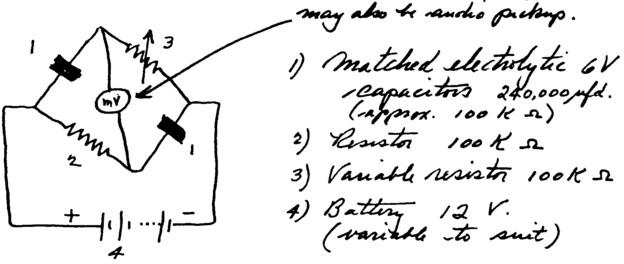
It now appears that electrolytic capacitors undergo resistance changes of possible cosmic origin which are not shared by standard resistors to the same
extent, A bridge circuit to establish a null provides a very sensitive detection circuit. By using an audio amplifying system in place of the
millivolt meter, audio detection of the incoming (cosmic) signals may be possible. Care must be taken to avoid exceeding the capacitors’ working
voltage. Hence, the battery voltage must be evenly divided between the resistors and the capacitors.
 Page 148
243. Comparison --- Electrolytic Sensors and Rocks.
Page 148
243. Comparison --- Electrolytic Sensors and Rocks.
Sunnyvale, Feb. 3, 1976.
The recent discovery that electrolytic capacitors of very high capacitance are similar in behavior to rocks is surprising and perhaps quite significant.
The problem in this ongoing research has always been the behavior of massive high-K dielectrics. Aluminum electrolytic dielectrics are certainly included
in this classification.
The fundamental phenomenon seems to be the spontaneous generation of an emf so-called self-potential. Concurrently, an apparent change in resistance is
present. At first glance, one would conclude that the emf is caused by an internal battery action of chemical origin (galvanism). This would be
especially understandable in the case of electrolytic capacitors, but would not be explicable with rock self-potential. Even so, the emf developed would
surely be temperature dependent, and this, it appears, is true.
When one considers the changes in resistance (or conductivity) of both electrolytic capacitors and rocks, apart from their self-potential
(counter-emf), the thought of a penetrating ionizing radiation presents itself. Any increase in such radiation would cause an increase in conductivity
or a decrease in apparent resistance.
 Page 149
Page 149
If K-waves exist, coming from space, the change in dielectric constant of both capacitors and rocks would, conceivably, cause proportionate voltage
changes. But these would not be conductivity changes, only apparent resistance changes caused internally by the so-called counter-emf. Hence, it becomes
important to distinguish between true changes in emf and conductivity. These factors are not readily separated. Only by concurrently observing each one
separately can this be accomplished.
Effects of Temperature ---
There is a direct relationship, although somewhat complex and certainly not proportionate, between temperature and self-potential.
Conductivity is also directly related, but also complex and not proportionate.
Both self-potential and conductivity are influenced (obviously) by unknown external factors. Hence, to obtain pure results, all tests must be conducted
at constant temperature.
Glitches ---
Both positive and negative glitches have been observed. If ionizing radiation is considered, a sudden increase (flare) would cause an increase in
conductivity in all sensors, possibly also in self-potential.
However, it is noted that glitches are usually negative (in electrolytic sensors) and therefore would indicate a decrease in ionizing radiation (if
such exists).
 Page 150
Page 150
This hardly seems plausible in view of such possible effects as gamma ray bursts or cosmic ray showers, which always increases in ionization and, hence,
increases in conductivity.
Changes in ambient (or internal) K, as from the passage of a K-wave would (1) increase the emf as K is lowered, and increase current flow or apparent
conductivity; (2) decrease the above if K is raised.
A negative glitch, therefore, may mean a momentary increase in ambient K. Diurnal changes, as reported in Sec. 233, could mean, therefore, K is high
when V is down, making the curve of K similar to the curves shown on p. 135, that is, highest at noon, lowest about midnight.
Conclusions:
It now appears that ionizing radiation is not responsible for the observed effects, either in capacitors or rocks.
Another presently unknown factor must be responsible.
K-waves or gravitational radiation are candidates, but no conclusions can yet be reached.
T. Townsend Brown (2-3-77)
 Page 151
Page 151


 Please be advised that this document is copyrighted © by The Townsend Brown family. All rights reserved.
Please see Legal and Copyright Information for additional copyright information.
Please be advised that this document is copyrighted © by The Townsend Brown family. All rights reserved.
Please see Legal and Copyright Information for additional copyright information.

















































































